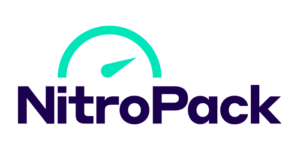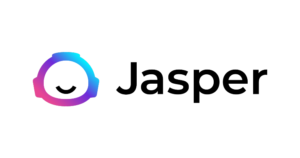In today’s world, anyone can share knowledge or learn something as easily as it is to click on a YouTube video. Everywhere you turn, there are avenues for learning.
However, to understand a topic in-depth, it may not be sufficient just to watch a 15 min YouTube video.
But that raises a problem. Where do you turn to learn what you need to know?
With so many learning platforms available, finding the best place to get knowledge can be a bit confusing.
If you are a teacher, what is the best platform to impart knowledge to students?
Thankfully, we have done the research. We have done the work and narrowed the options to a list that will benefit both students and teachers.
Keep reading to learn how to make the most of the best online course platforms in 2024. In this article, you’ll see our top picks where you can sell online courses or learn some.
Here are our top 5 picks for both students and teachers:
-
Thinkfic: Best Overall for Students and Teachers. Create, market, learn or sell online courses on this platform. It gives you total control of your courses or business.
-
Kajabi: This is the best online platform for professionals. If you are learning, there is an abundance of learning materials on this platform. You can also sign up for coaching programs, podcasts, and many more.
As a course creator, you get paid premium prices for your courses.
-
Teachable: This is the best platform for beginners – whether this is your first time creating a course or learning one.
Since the platform is pretty easy to use, you can easily locate a course of your choice. And this helps teachers because it turns their expertise into a booming business.
-
Coursera: Best online platform for free courses. If you are interested in learning but do not want to pay the transaction fees, Coursera is the answer.
And if you are interested in selling online courses but do not know how the public will take them, you may decide to put it up as a free course on Coursera and see how the public embraces it before putting a price tag on it.
-
Udemy: Best online platform offering a wide range of courses. Since Udemy has a vast library of courses, it is a favorite among students. And it is a good online business for teachers selling their courses.
How We Evaluate Online Course Platforms
There are certain things we use to judge an online course platform, which include:
How easy is the platform to use?
We want something intuitive and easy to navigate; no one wants to spend hours trying to figure out how to watch a video or upload a file.
Second, we look at the features offered by the platform.
What kinds of things can you do with it? Can you learn different types of content? Are there tools for collaboration and communication? Does it integrate with other software?
The more features a platform has, the better!
If you intend to create online courses, this feature is especially important for you to sell courses.
Also, we know that platforms with solid communities can be incredibly valuable. Community members can offer support and advice from other users who have been through the same material.
Finally, we consider the price. Obviously, we want something affordable but also something that offers good value for money. If you want to create online courses, you’ll want to go for a platform that takes a very low commission for every course sold.
So, a platform packed with features that cost an arm and a leg will not be attractive to us.
Whether you intend to sell online courses or buy them, these factors are incredibly important.
If a platform ticks all those boxes, it’s likely to be a winner in our books!
Stick around to discover our top picks, how to maximize the potential of online course platforms, and many more.
32 Best Online Course Platforms
To make it easier to find one that applies to you, we’ve split our list into 2 sections:
In the first section, we’ll look at the best online course platforms that you can use to create and sell online courses to the public.
In the second section, we’ll look at online learning platforms where you can learn and engage with a large community.
Best Online Learning Platforms
Coursera:
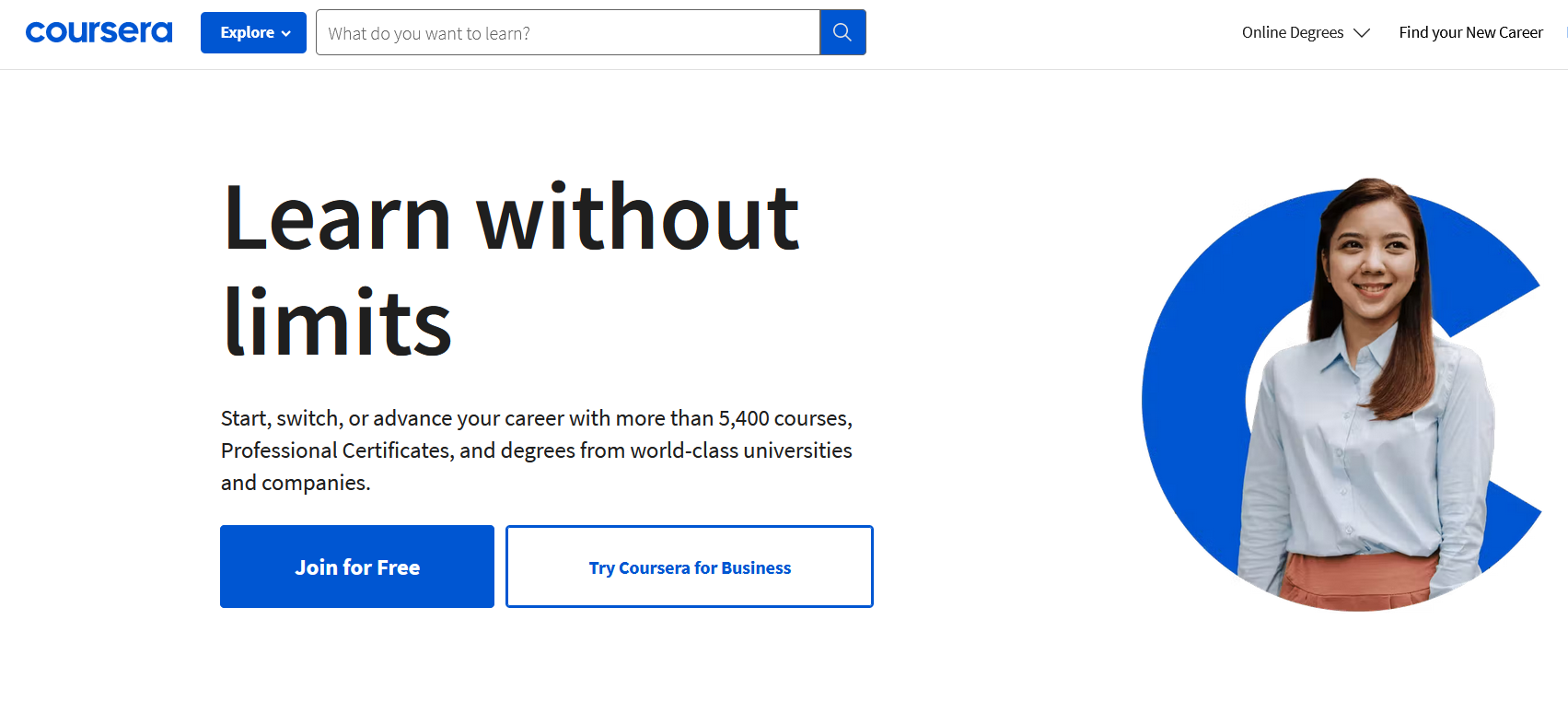
Coursera is an online education platform that offers courses from top universities and companies. You can learn anything from programming to business to cooking.
The courses are typically 4-6 weeks long, and you can either audit the course for free or pay for a certificate.
I’ve personally taken a few courses on Coursera, and I really like it. The instructors are usually experts in their field, and you get your money’s worth.
Coursera is a great way to access some of the best educational content available. Plus, the platform offers a wide range of specializations you can choose from to enhance your knowledge further.
If you are an expert in your field and are thinking of selling online courses, Coursera is the best online course platform to do this.
Since Coursera was founded in 2012 by two former Stanford professors, you’ll surely find other Academics like yourself also offering courses there.
The only downside is that there is no interaction with other students. Still, I think Coursera is great for anyone looking to learn new skills.
Udemy:

Udemy is a free online course platform and a great place to learn new skills or improve ones you already have.
It has a vast library of courses (over 130,000) and an impressive list of expert teachers.
The best part; you can learn from the best for free! That’s right; there are hundreds of free courses available.
It has a wide range of topics, including business, technology, photography, health & fitness, and more. You can access Udemy on any device 24/7.
This platform is excellent for anyone looking to learn something new or expand their knowledge base in several areas.
With hundreds of courses available on practically every subject imaginable, there’s sure to be something to fit your needs.
You also get a certificate of completion after finishing the course.
As an expert, Udemy may be the right fit for you. This platform allows course creation for everyone. As a professional, you can use training materials like videos, Powerpoint text, and PDF documents.
Overall, Udemy is an excellent platform for learning new skills or expanding your knowledge base. And at $10-$20 per course, it’s very affordable too!
Udacity:
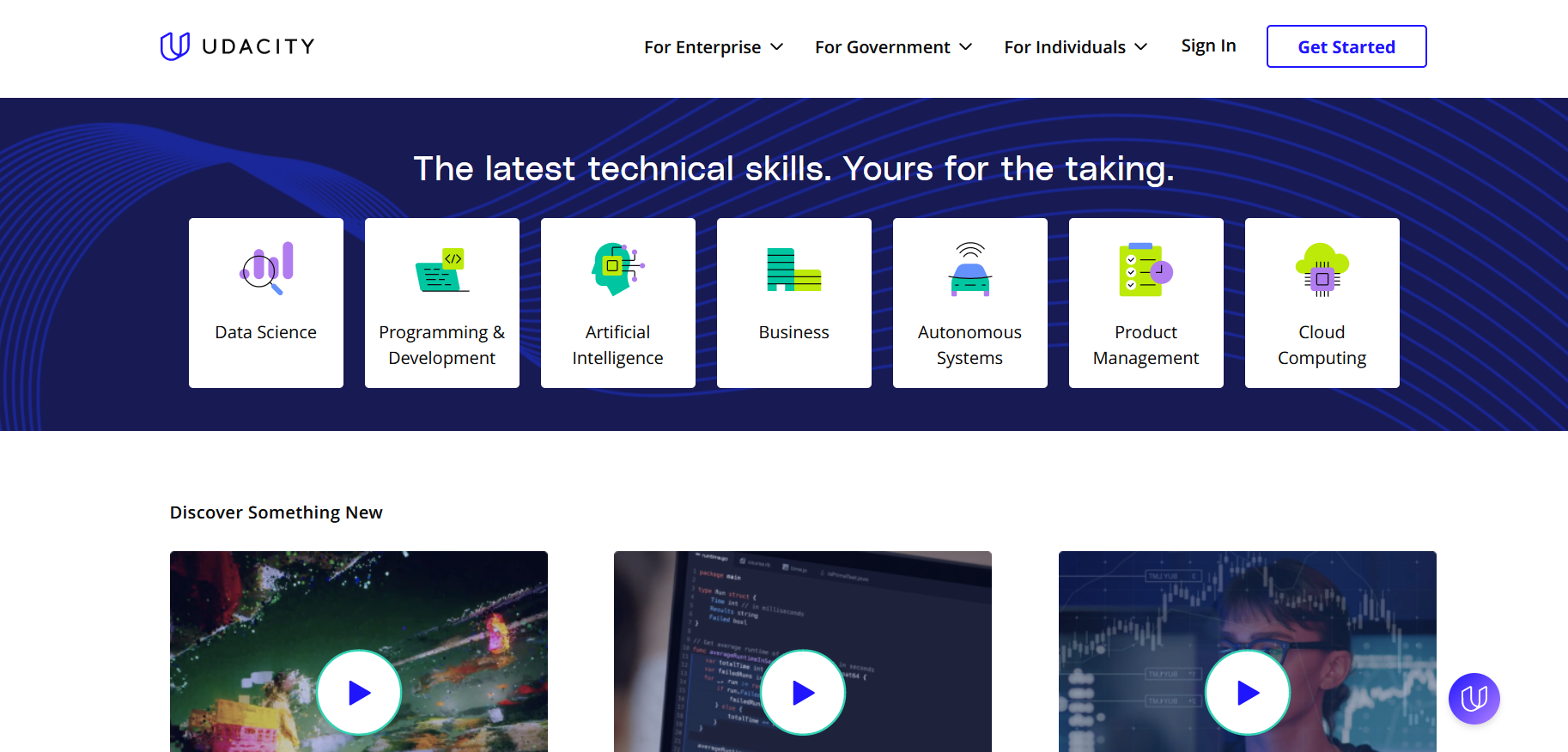
Udacity is an online course website with a twist.
Most online learning platforms focus on static content like videos and readings. Udacity, on the other hand, focuses on interactive activities and projects that require students to use what they’ve learned.
This makes for a more engaging and effective learning experience and a more memorable one.
This is why it is one of our best online learning platforms.
So what exactly does Udacity offer?
For starters, all their courses are self-paced, so you can learn at your own pace and on your own schedule.
They also offer a wide range of courses, covering everything from programming to data science to artificial intelligence. And if you’re unsure which course is right for you, they have a handy quiz to help you figure it out.
What’s more, Udacity offers both free and paid courses. Their free courses are called “Nanodegrees,” and their paid courses are called “professional certificates.”
Nanodegrees are essentially mini-courses that cover specific topics in-depth, and they’re perfect for getting started with Udacity or brushing up on a particular skill.
On the other hand, professional certificates are designed for people who want to get ahead in their careers by adding new skills to their resumes.
Either way, with courses made by professionals and frequent interactions with instructors, this platform puts you at the forefront of future trends and best practices.
Udacity is good for you if you intend to sell courses or if you are about to start with your online courses.
All in all, Udacity is an excellent platform for anyone who wants to learn new things and further their career. So what are you waiting for? Sign up today!
Skillshare:
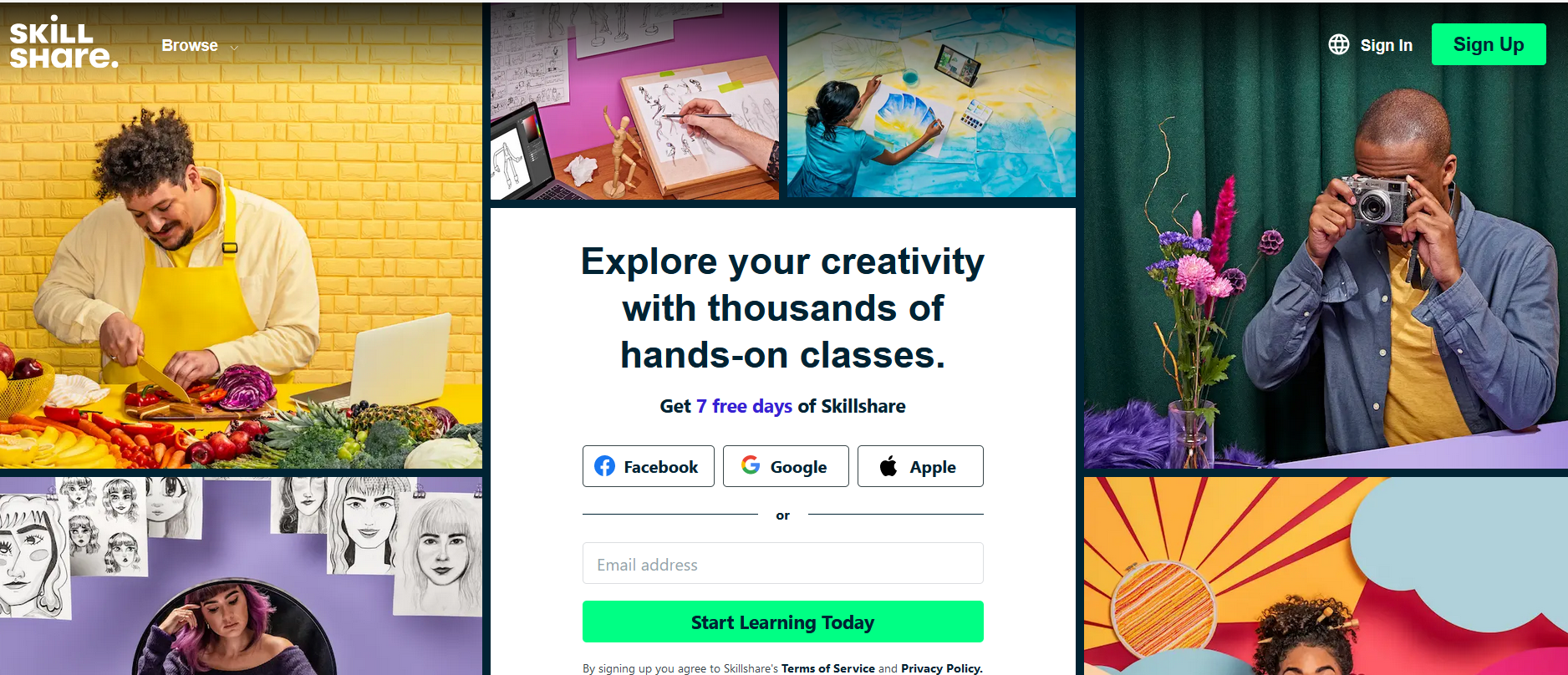
Skillshare is a great online course software for creative and entrepreneurial types. This platform has something for everyone, from photography to graphic design to programming.
With its focus on helping people learn what they love and create meaningful careers, Skillshare is perfect for those looking to become experts in their chosen field.
It offers its users many features and resources to help them develop and learn new skills. The site is also great for networking and connecting with like-minded people.
Here’s a quick overview of what Skillshare has to offer:
-
A library of high-quality online courses taught by experts in their field.
-
The ability to create and share your own lessons.
-
A thriving community of creatives and entrepreneurs
-
Tools and resources for developing your skills, and much more!
Whether you’re looking to learn something new or brush up on your existing skills, Skillshare is definitely worth checking out.
edX:

edX is a massive open online course (MOOC) provider. It hosts online university-level courses in a wide range of disciplines to a worldwide student body, including some courses at no charge. It also conducts research into learning based on how people use its platform.
Founded by Harvard University and MIT in 2012, edX is an early pioneer in the MOOC space. The nonprofit’s mission is “to increase access to high-quality education for everyone, everywhere.”
In May 2013, the first edX class, Circles, was launched. Since then, edX has seen tremendous growth; as of September 2019, it offers over 3,900 courses from 140 institutions to over 18 million students.
edX courses are designed to be highly interactive and engaging. They include videos, quizzes, and exercises and are often taught by world-renowned professors from top universities. Courses are self-paced but have deadlines for assignments, so students need to be disciplined to finish them.
While many edX courses are free to take, there is also a growing selection of paid courses that offer additional features such as verified certificates (signed by the instructor), 1-on-1 mentoring sessions with instructors, and other value-added services.
Whether you want to learn something new or expand your existing knowledge base, edX is worth checking out! It is also a great online course software for professionals.
With its flexible course offerings and easy navigation, edX is perfect for anyone looking to take their learning journey into their own hands. With over 3000 courses from some of the best universities worldwide, you’ll surely find something to fit your interests.
Khan Academy:

Khan Academy is a free online educational resource that offers courses in various subject areas. The site was founded in 2006 by educator Salman Khan to provide free, high-quality education for everyone, regardless of location or economic circumstances.
The Khan Academy website features a variety of resources, including video lessons, practice exercises, and articles on various topics. There is also a community forum where users can ask questions and receive help from other members.
One of the things that make Khan Academy so great is its flexibility. Users can choose to watch the video lessons at their own pace or speed through them if they want to.
Additionally, the site offers interactive exercises that allow users to check their understanding of the course immediately.
Khan Academy is an excellent resource for anyone who wants to learn more about a particular subject or brush up on their skills. Whether you’re a student, teacher, parent, or just someone wanting to learn something new, Khan Academy is worth checking out!
With its focus on personalized learning and mastery-based approach, Khan Academy is perfect for anyone looking to develop their skills at their own pace. Plus, with its library of over 6000 courses, you can find something that fits your needs.
Codecademy:
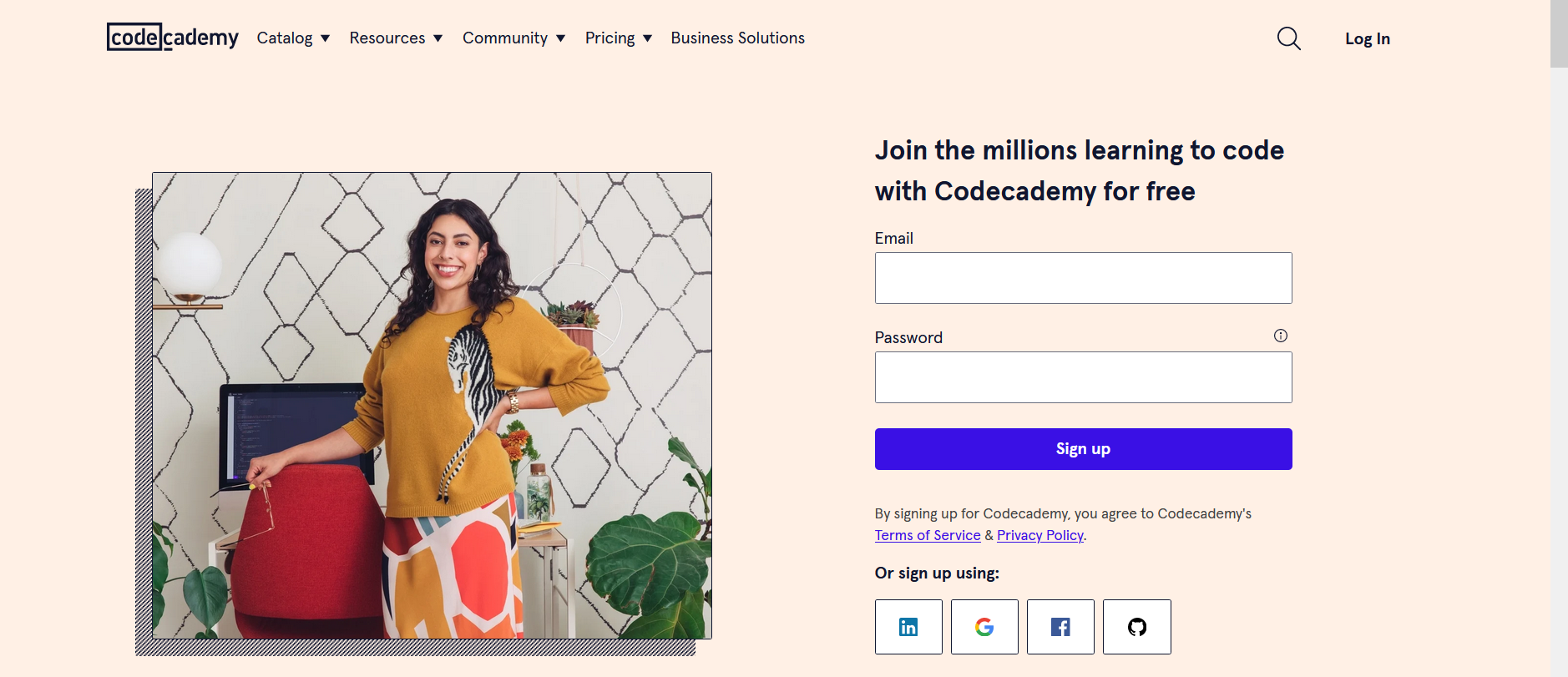
If you want to learn how to code, one of the best places to start is Codecademy.
Professionals offer a variety of courses for people of all levels, from complete beginners to experienced developers.
The courses are well-structured and easy to follow, and the interactive exercises make learning fun and engaging. Plus, there’s a built-in code editor, so you can practice your skills as you go.
So, what exactly is Codecademy?
In a nutshell, it’s an online learning management system that offers free coding courses in various programming languages. Whether you want to learn HTML/CSS, Java, Python, or anything else, they’ve got you covered. And if you get stuck on any of the exercises, there’s a helpful community of coders who are always happy to help.
So why should you learn how to code? Well, coding is becoming increasingly important in our digital world. If you can code, you have the power to create websites, apps, and even games. And with Codecademy by your side, learning how to code is easier than ever before!
With its interactive learning experience, Codecademy is perfect for anyone learning the basics of coding and programming. Plus, with scores of free resources and lessons available, it’s a great way to get started in the world of coding.
Treehouse:
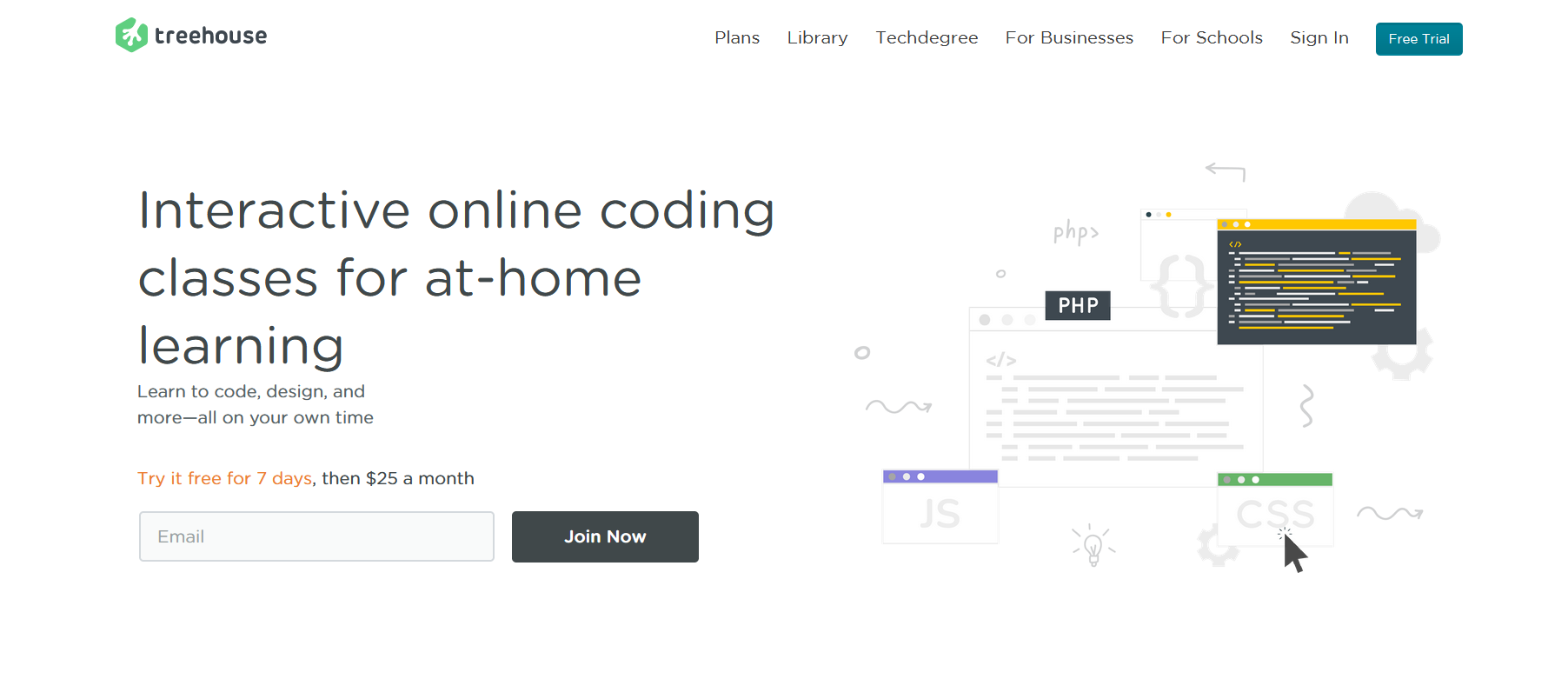
Whether you’re looking to learn coding, web development, or any other in-demand skill, Treehouse is a great place to start.
The online course platform offers comprehensive, well-made courses taught by experienced instructors. And with new courses added every week, there’s always something new to learn.
But what makes Treehouse really stand out is its focus on hands-on learning.
Rather than just watching lectures and taking quizzes, you’ll build projects as you work through each course. This allows you to put your new skills into practice immediately and see how they work in the real world.
In addition, Treehouse offers several perks that make it an attractive option for learners of all levels. These include a personal profile page where you can track your progress, a friendly community forum, and even job placement assistance once you’ve completed your courses.
So if you’re looking for a comprehensive, hands-on learning experience, Treehouse is definitely worth checking out.
Lynda:
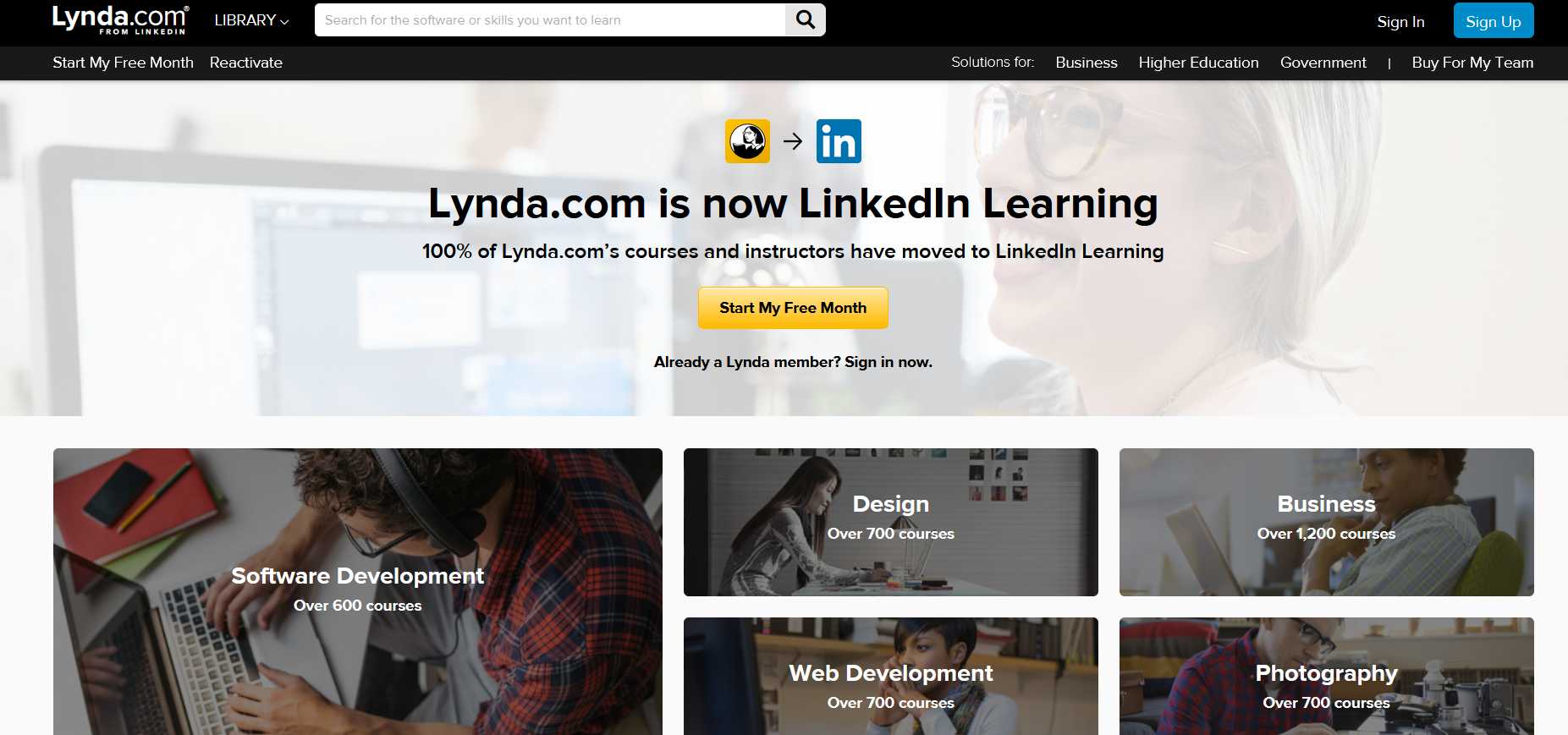
Lynda is an excellent option if you’re looking for a comprehensive online course platform.
It offers many courses covering everything from business and technology to design and photography. And best of all, it’s easy to use and navigate.
The courses are taught by experienced instructors who know their stuff.
One thing that makes Lynda stand out is its extensive course library. You can find courses on any topic you can think of, whether you want to learn about website design or improve your Photoshop skills. And new courses are continually added, so there’s always something new to learn.
Lynda is also great if you’re unsure what to learn. Its “Learning Paths” feature lets you explore different topics and find the right path for your goals. Each course comes with downloadable resources and exercise files, so you can follow along at your own pace.
So if you’re looking for an online learning platform that offers high-quality courses, a wide range of topics, and plenty of helpful resources, Lynda is a great option.
With its wide range of courses and excellent instructors, Lynda is perfect for anyone looking to master digital media or creative design skills. Plus, with a subscription-based model, you can access the entire library of resources at an affordable price.
Pluralsight:
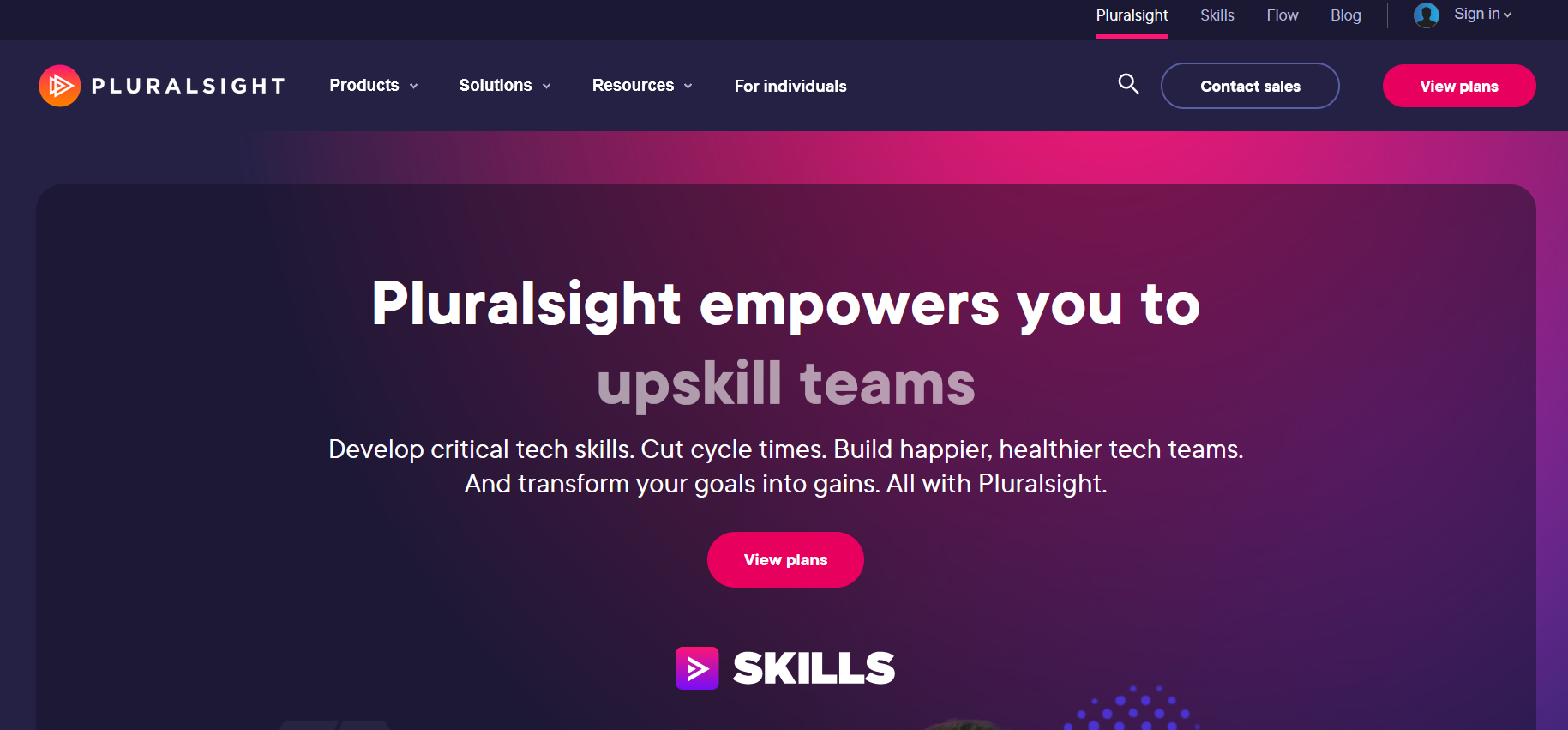
If you’re looking for a comprehensive, top-quality online learning platform, Pluralsight is worth checking out.
With over 5,000 courses on everything from programming and IT to creative skills like graphic design and 3D animation, there’s something for everyone. And because all of the courses are taught by expert instructors, you can be sure you’re getting a high-quality education.
But what makes Pluralsight really stand out is its interactive learning experience. Most courses include interactive exercises and labs so you can practice what you’re learning as you go.
And if you ever get stuck, there’s a massive community of experts who are always happy to help.
Plus, with Pluralsight’s flexible monthly subscription plan, you can learn at your own pace without breaking the bank.
With its focus on helping people learn new skills and advance their careers, Pluralsight is perfect for anyone looking to develop their knowledge in the IT industry.
Plus, with thousands of courses available and an ever-growing library of content, this platform can help you stay up to date on emerging trends and technologies.
Alison:
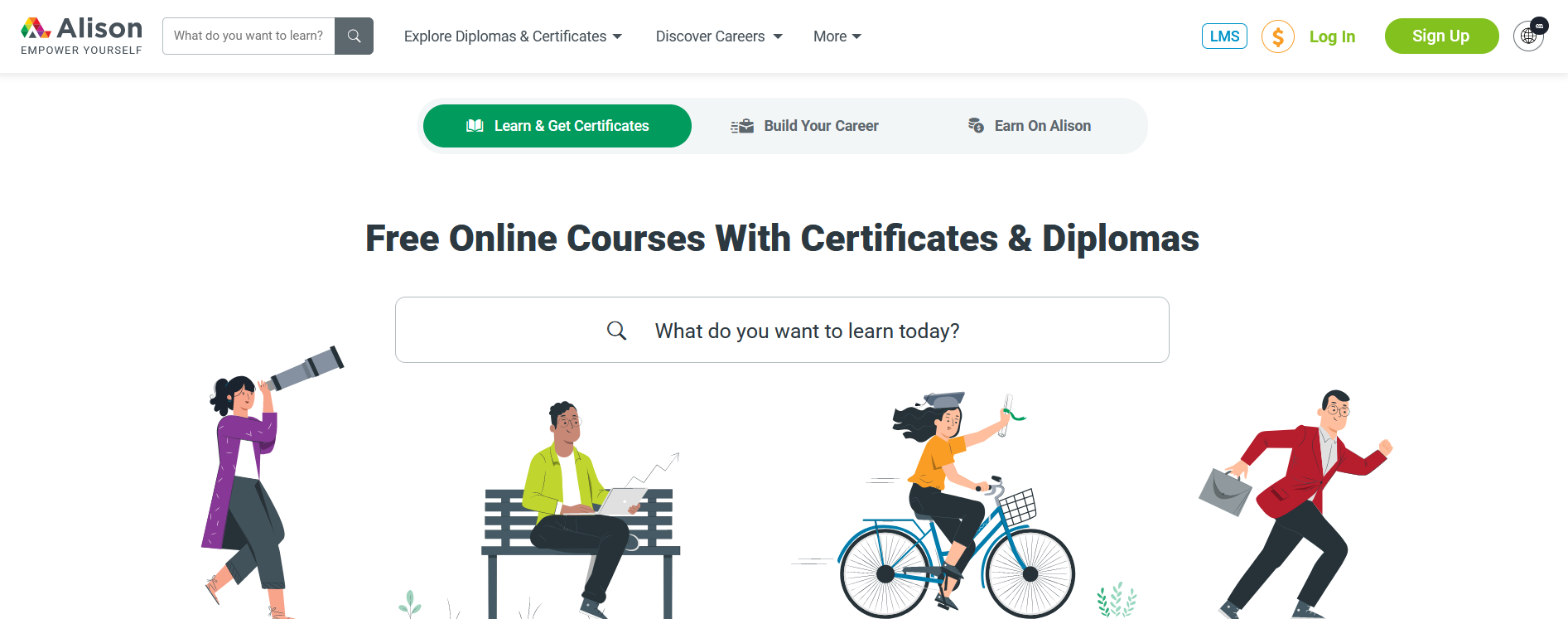
Alison is an online learning platform that offers free courses in a variety of subjects. You can find courses on everything from business to cooking, and each course is taught by an expert in the field.
The courses are self-paced, so you can work through them at your own speed, and they’re flexible enough to fit into your busy schedule.
What’s great about Alison is that it’s totally free to use – there are no hidden costs or catches. You can sign up for as many courses as you like, and you’ll never be charged a penny. Plus, the classes are comprehensive and easy to follow, so you’ll be sure to get everything you need out of them.
So if you’re looking for a way to learn new skills and improve your knowledge, Alison is the perfect solution. With its wide range of courses and expert instructors, it’s guaranteed to help you reach your goals.
CodeSchool:

If you want to learn how to code but don’t want to spend a fortune on a coding boot camp, CodeSchool might be the right fit for you.
With both in-person and online courses, CodeSchool offers a variety of ways to learn how to code. And, with classes taught by experienced developers, you can be sure you’re learning from the best.
So whether you’re a coding newbie or an experienced developer looking for a refresher course, read on to find out if CodeSchool is suitable for you.
With its interactive lessons and fun projects, Code School is perfect for anyone looking to learn the basics of coding. Plus, with its library of over 200 courses and an ever-growing list of content, this platform will help you hone your skills in no time.
FutureLearn:
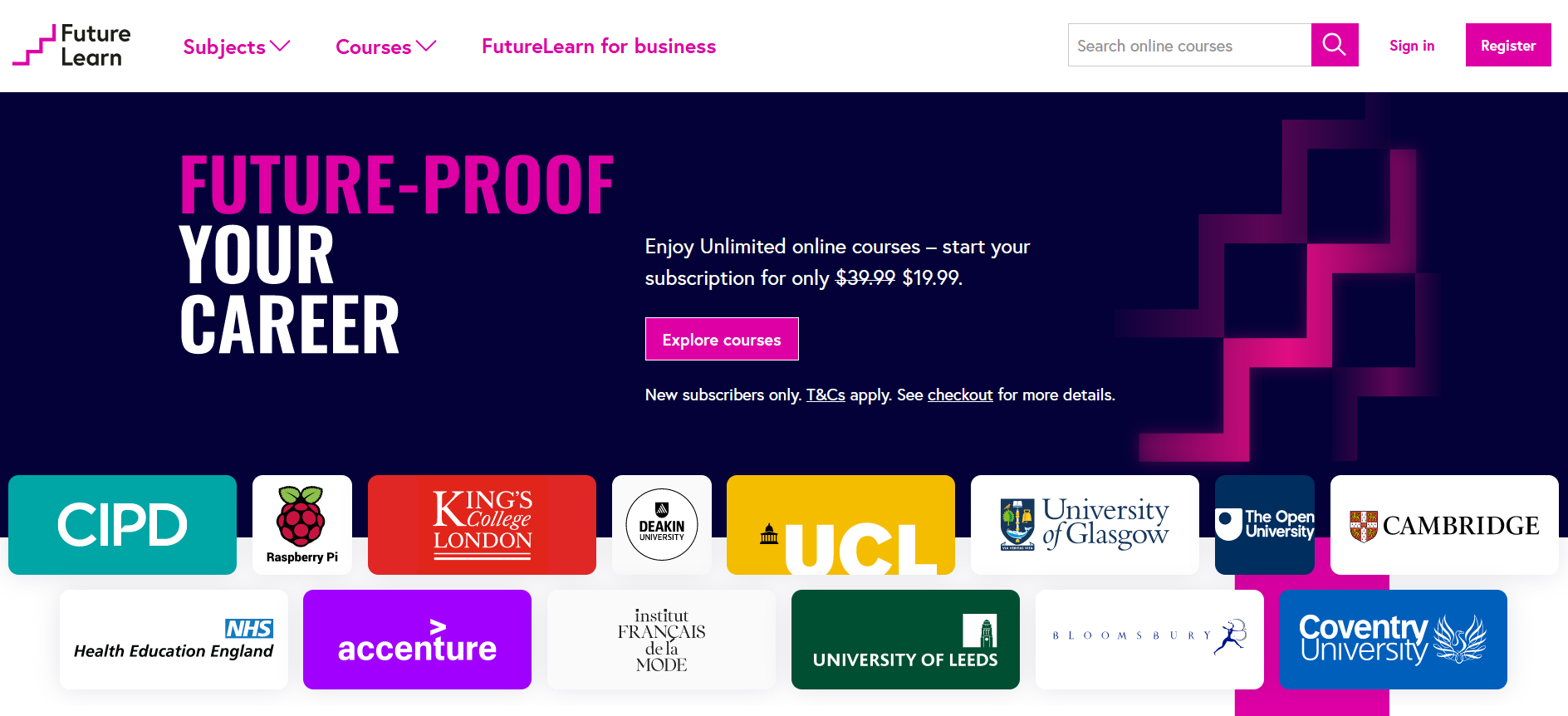
FutureLearn is a great online learning platform that offers many courses from top universities and organizations. The courses are flexible and can be completed at your own pace. FutureLearn also provides certificates and badges to show off your achievements.
What makes FutureLearn great is its ability to cater to different learning styles.
The courses are interactive and engaging, making them perfect for those who prefer a hands-on approach to learning.
Plenty of multimedia resources, such as videos and infographics, appeal to those who prefer a more visual learning style.
FutureLearn is also great for those who want to learn new skills or gain knowledge in specific subject areas. Whether you’re looking to improve your CV or expand your horizons, FutureLearn has something for everyone.
With so many courses on offer, there’s sure to be something that interests you. So why not give it a try? You could soon be on your way to becoming a FutureLearner!
LinkedIn Learning:
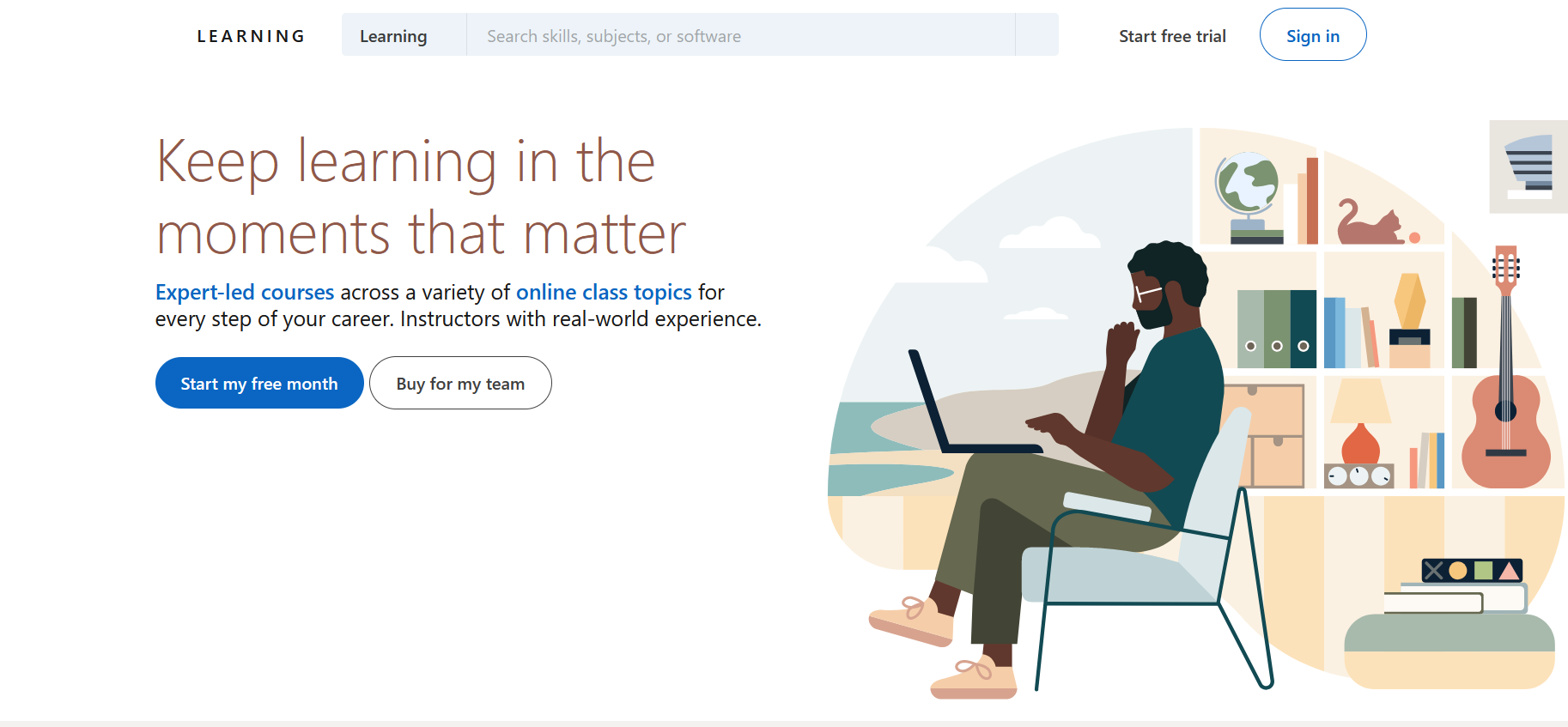
LinkedIn Learning is an online learning platform that offers courses in a variety of topics, from business and design to technology and web development.
LinkedIn Learning is an excellent resource for anyone looking to improve their skills or learn new ones, as it offers both high-quality course content and the ability to connect with other professionals in your field.
You can be sure you’re getting the latest and greatest information available when you take a course on LinkedIn Learning.
The Course Content on LinkedIn Learning is top-notch, with contributions from industry leaders across a wide range of industries. And if you’re ever stuck on a particular topic, the platform’s community feature allows you to reach out to other professionals for help.
What’s more, LinkedIn Learning is constantly adding new courses to its lineup, so you’ll always have something new to learn. LinkedIn Learning has the resources you need to succeed, whether you’re just getting started in your career or are looking to make a change.
Canvas Network:
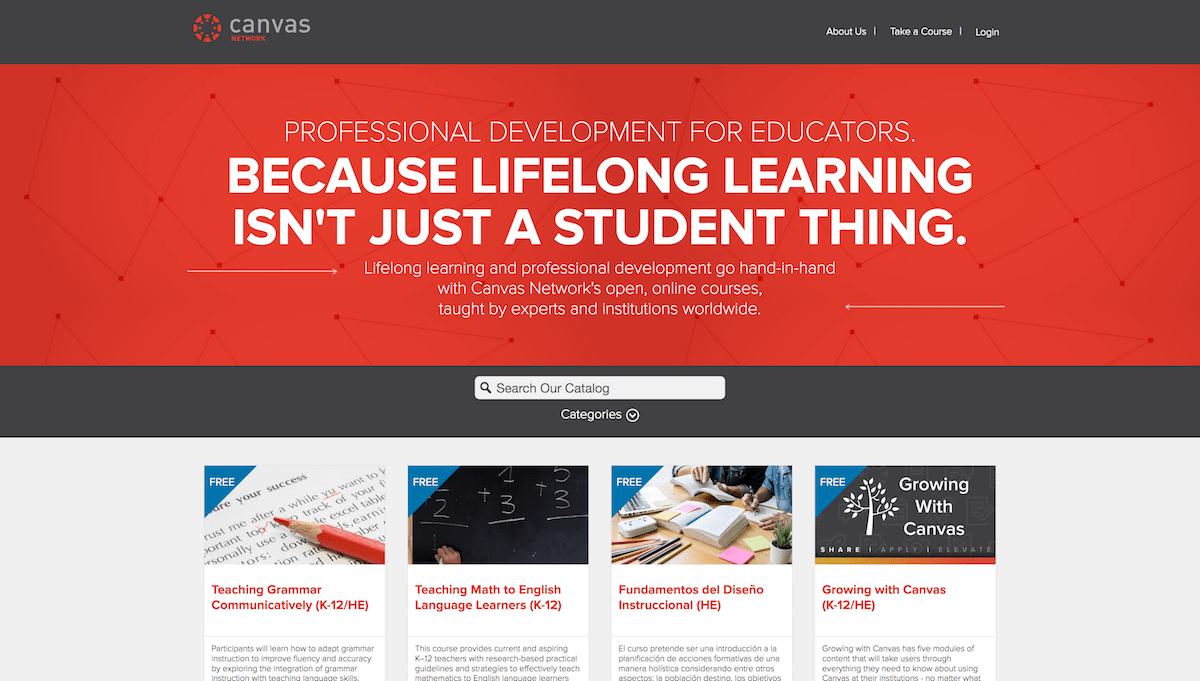
If you’re looking for an online learning platform that offers a little bit of everything, you’ll want to check out Canvas Network.
Created by Instructure, Inc., Canvas Network is a free and open online education platform that anyone can use anywhere.
With over 700 courses available on a wide variety of topics, there’s something for everyone on Canvas Network. And if you’re looking to create your own course, the platform makes it easy. You can also use Canvas Network to collaborate with others on projects, share resources, and more.
What makes Canvas Network stand out from other online learning platforms is its flexibility and ease of use. Whether you’re a teacher looking for a new way to engage your students or a lifelong learner looking for interesting new courses, Canvas Network is worth checking out.
Masterclass:
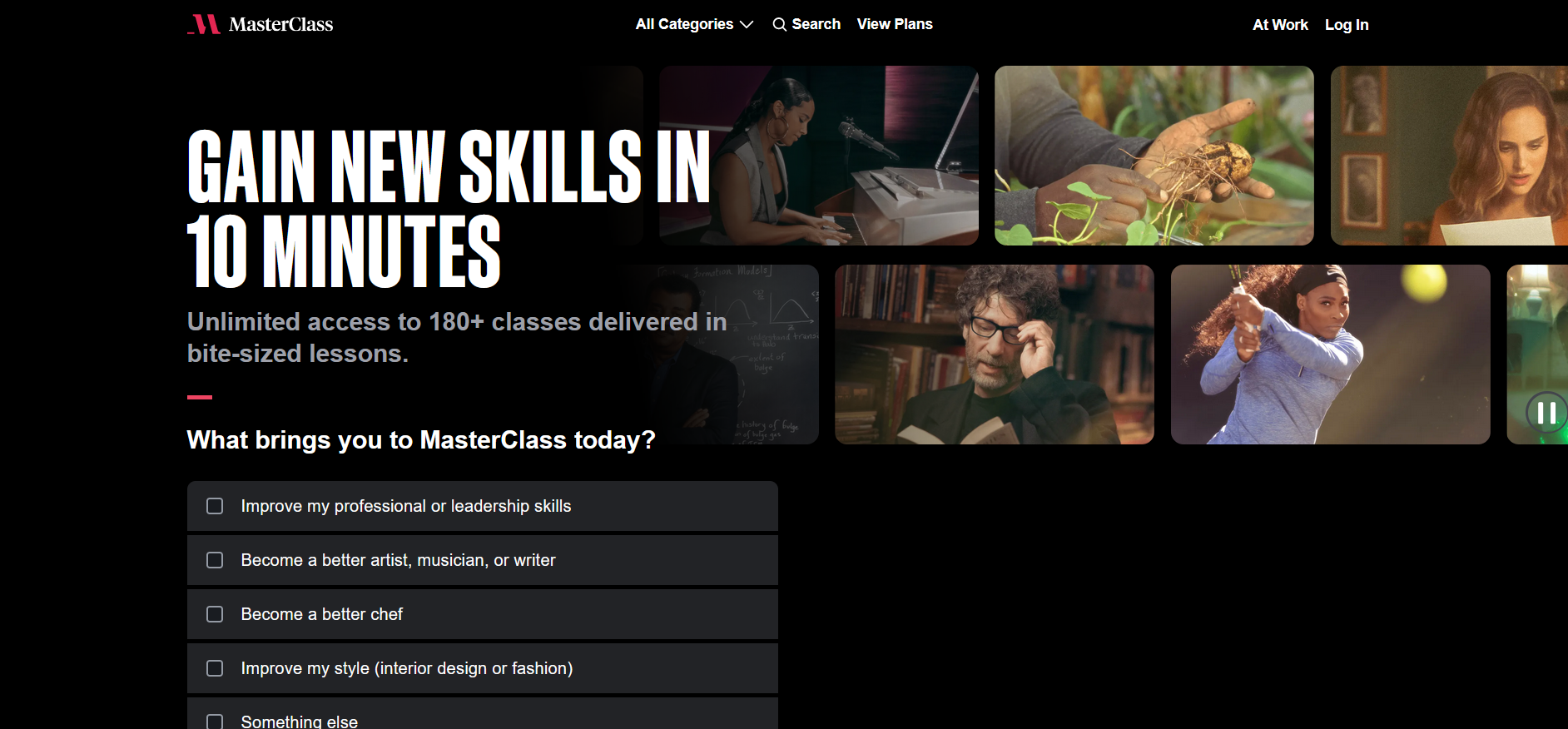
MasterClass is an online education platform that offers courses taught by world-renowned instructors. The classes are designed to give you an immersive, intimate look at how the masters of their craft operate. Whether you’re interested in cooking, writing, or acting, MasterClass has a course for you.
The courses are all incredibly well done and offer much value for the price. The instructors are all experts in their field and do a great job of breaking down their processes so that anyone can understand and learn from them. MasterClass also offers many helpful resources, such as transcripts and follow-along exercises, so you can get the most out of each class.
Overall, MasterClass is an excellent resource for anyone who wants to learn from the best of the best. It’s well worth the price and will help you take your skills to the next level.
Academy of Mine:
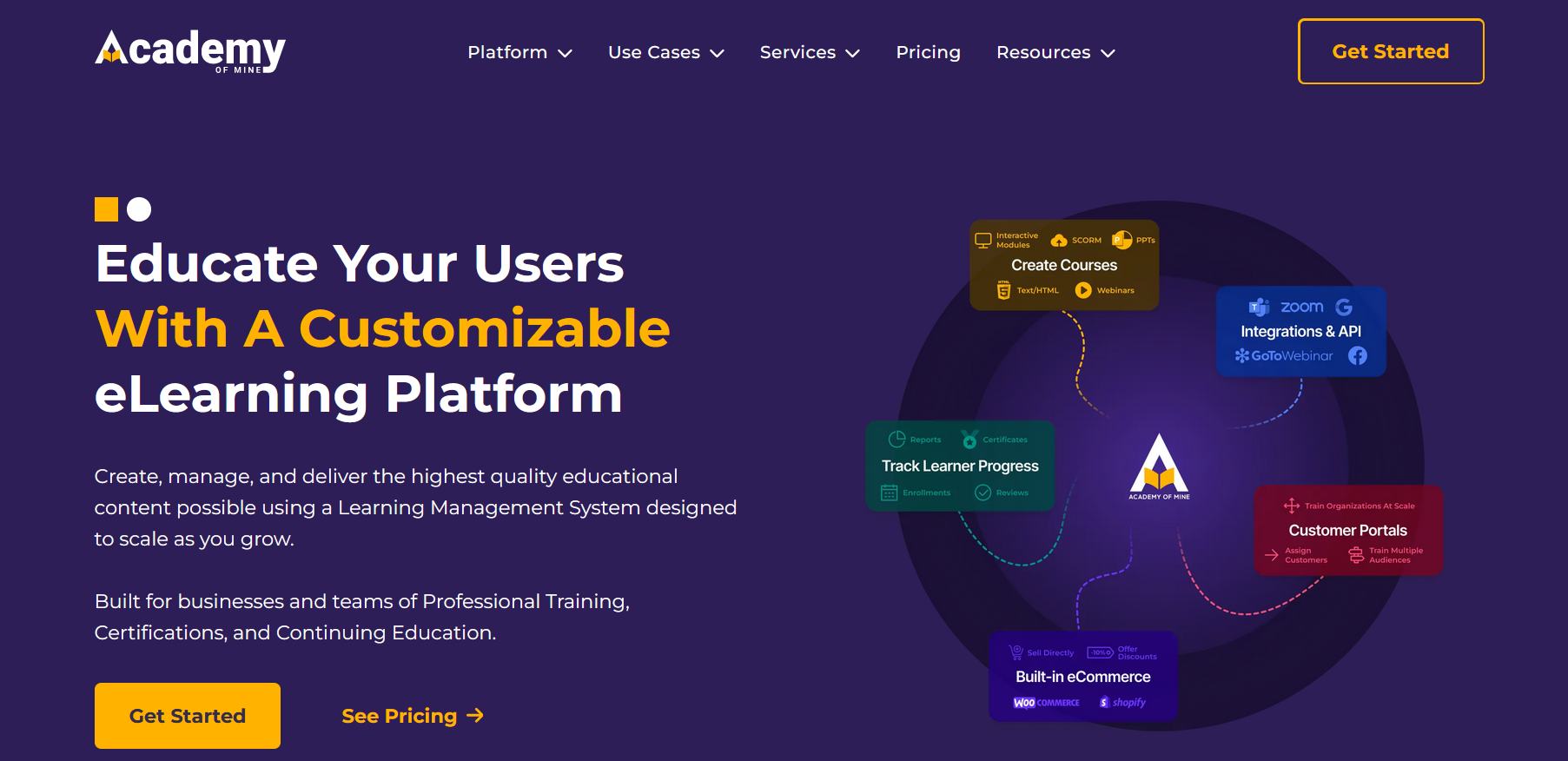
The Academy of Mine is an online learning platform that offers a wide range of courses and programs. It is a great resource for anyone looking to learn or improve new skills.
The Academy of Mine has a wealth of features that make it a great learning tool, including:-
-
A wide range of courses and programs:
The Academy of Mine offers a wide variety of courses and programs, making it a great resource for anyone looking to learn new skills or improve their existing ones.
-
A wealth of features:
The Academy of Mine has a wealth of features that make it a great learning tool. These features include the ability to track your progress, set goals, and receive feedback from instructors.
-
A supportive community:
The Academy of Mine has a supportive community that can help you through your journey of learning new skills. This community is made up of instructors, students, and staff who are all committed to helping you succeed.
EdApp
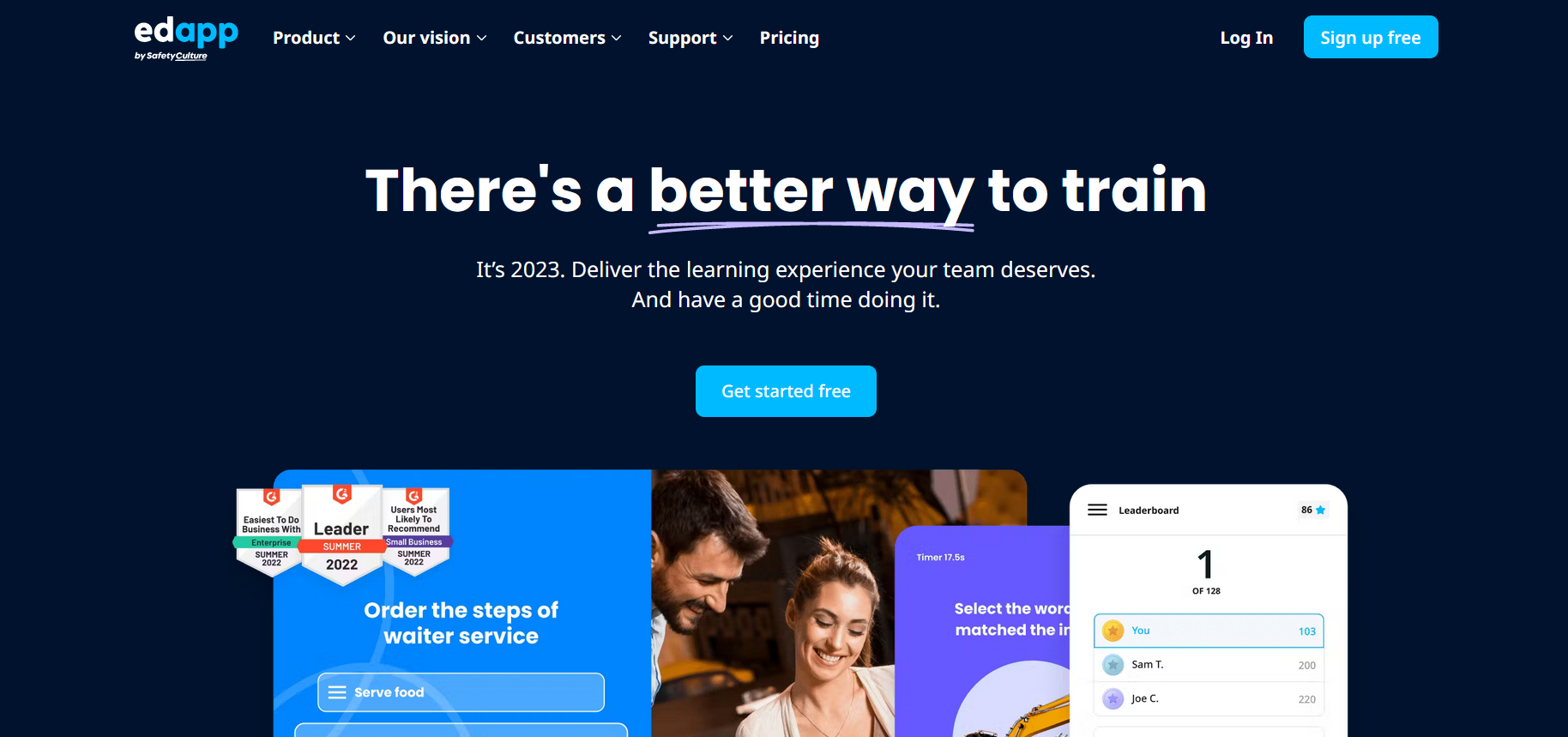
EdApp is a great mobile app for education. It offers a wide range of features and benefits, making it an essential tool for any student.
EdApp provides access to a vast library of educational resources, including textbooks, video lectures, and interactive quizzes. This makes it an ideal way to supplement your traditional classroom learning.
In addition, EdApp offers a unique feature called “Study Plans.” This allows you to create a personalized plan for studying for exams or completing assignments. The app will then provide you with customized content and reminders to help you stay on track.
Finally, EdApp is exceptionally user-friendly and well-designed. The interface is simple and easy to navigate, and the app is regularly updated with new features and improvements. Overall, EdApp is an excellent choice for anyone looking for a comprehensive mobile learning solution.
Arlo:
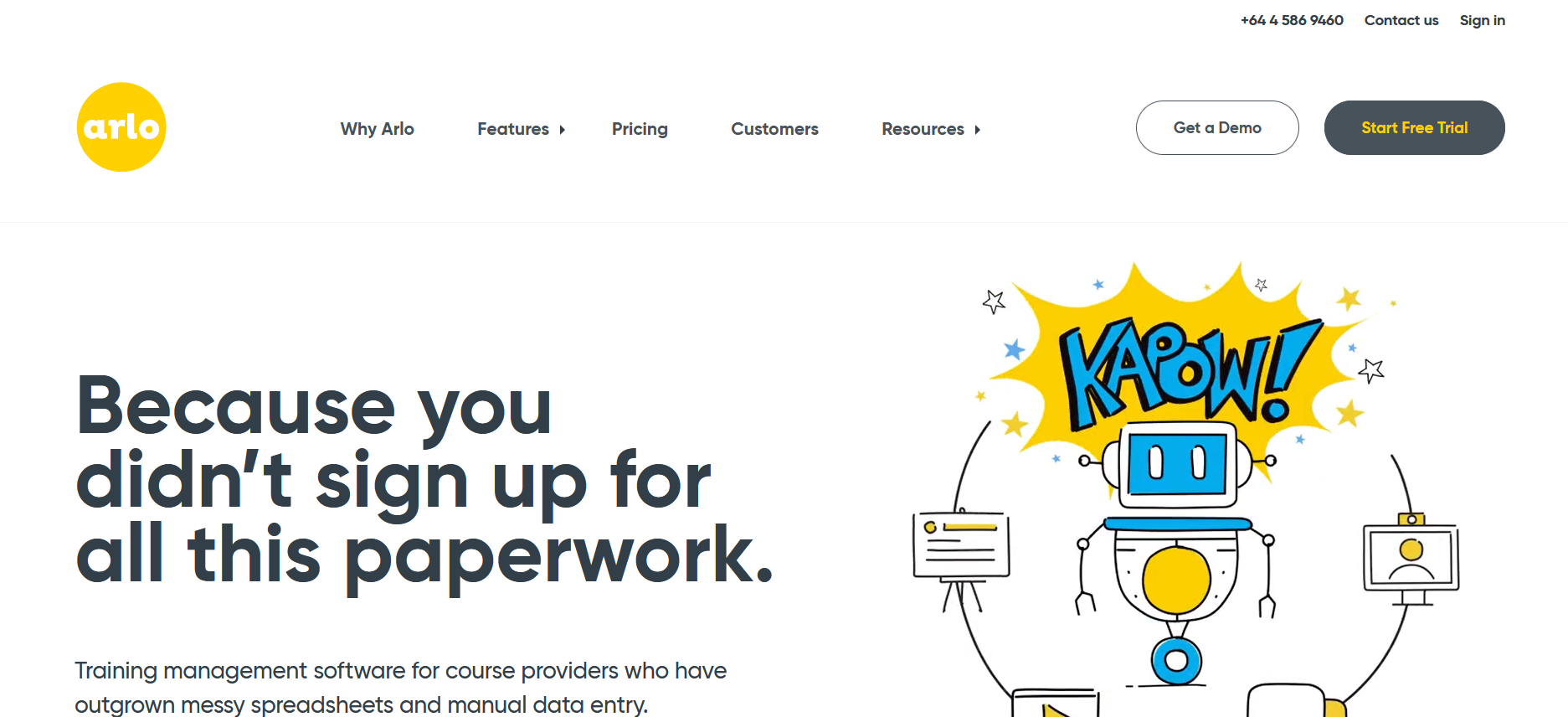
If you’re looking for one of the best online course platforms, Arlo is definitely worth checking out. Here’s a quick overview of what it has to offer:
Arlo offers a wide range of features that make it ideal for online learning. For starters, it’s very user-friendly and easy to navigate. Plus, it comes with all the essential tools and resources you need to create and manage your courses.
Moreover, Arlo makes it easy to track your progress and see how well you’re doing. And if you ever need help, a knowledgeable support team will assist you.
So why is Arlo such a great choice for online learning? Well, simply put, it’s one of the most complete and reliable platforms out there. With everything you need to get started, plus plenty of helpful resources and support, Arlo is the perfect platform for anyone looking to learn online.
Best Online Teaching Platforms
Thinkific
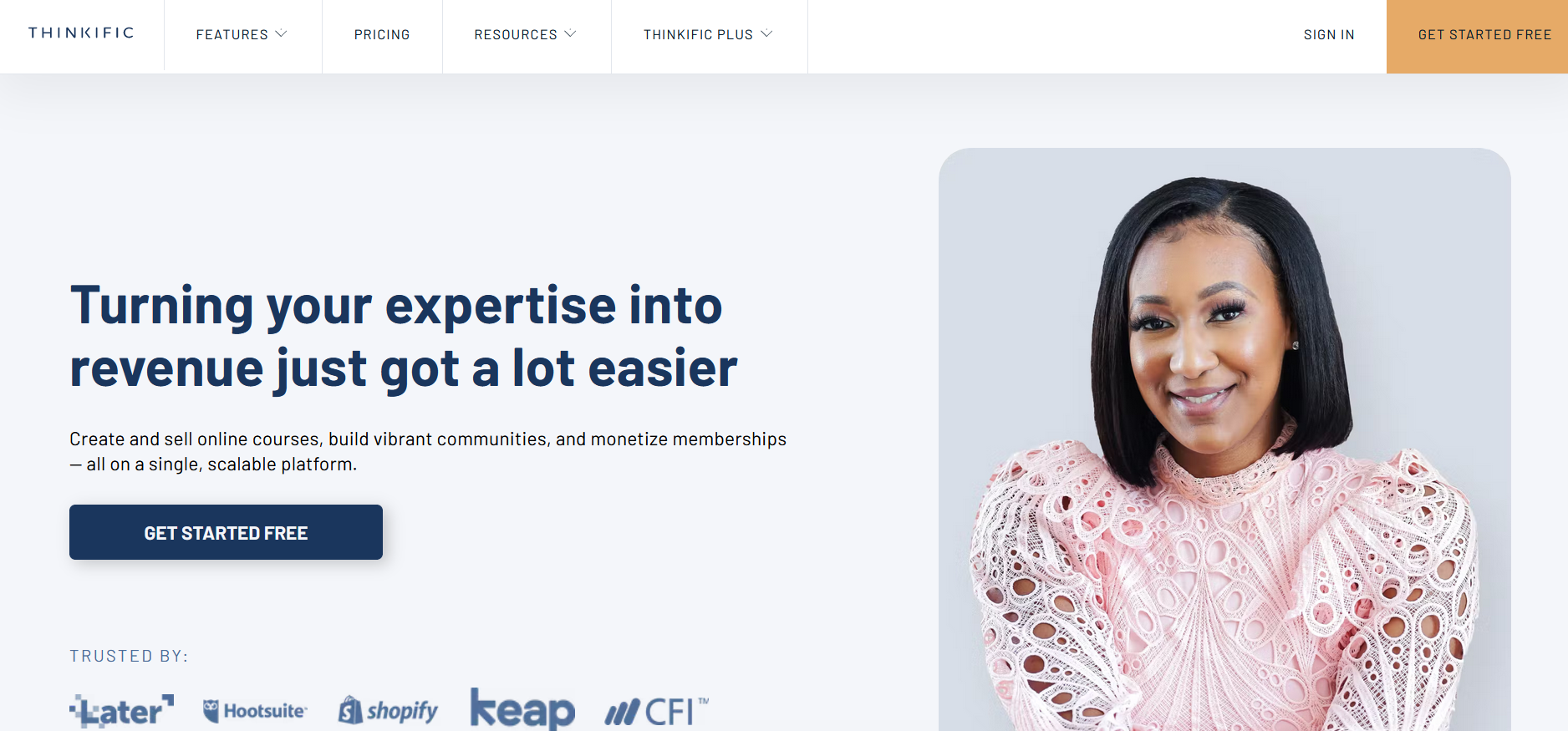
Thinkific is one of the most popular online course platforms. It’s simple to use, has many features and integrations, and is great for instructors and students.
Here’s an overview of what Thinkific is, what it does, and why it’s so popular.
Thinkific is an all-in-one platform where both course creation and learning are super easy. Since this platform offers multiple learning products, there is more than one way to earn. You’ll find courses of different types, including videos, quizzes, surveys, text, and images
Thinkific is one of the best online course platforms that helps instructors create, deliver, and sell courses online. The platform is simple to use and comes with various features, including content hosting, video streaming, course creation tools, integration with third-party applications, and more.
Thinkific also offers several services to help instructors promote and sell their courses, such as marketing consultation, course listing on the Thinkific marketplace, and instructor coaching.
What makes Thinkific so popular is its ease of use, its comprehensive feature set, and its focus on helping instructors succeed in selling their courses online.
That said, there are a few things to keep in mind if you’re considering using Thinkific to host your courses.
First, while the platform is easy to use, it doesn’t offer as much flexibility as other course platforms when creating custom courses.
Second, while Thinkific offers a lot of support for instructors selling their courses on the platform, it doesn’t have as much functionality for students taking classes (such as tracking progress or providing graded feedback).
Overall, though, Thinkific is an excellent option for Instructors looking for an easy-to-use platform with tons of features.
Kajabi:
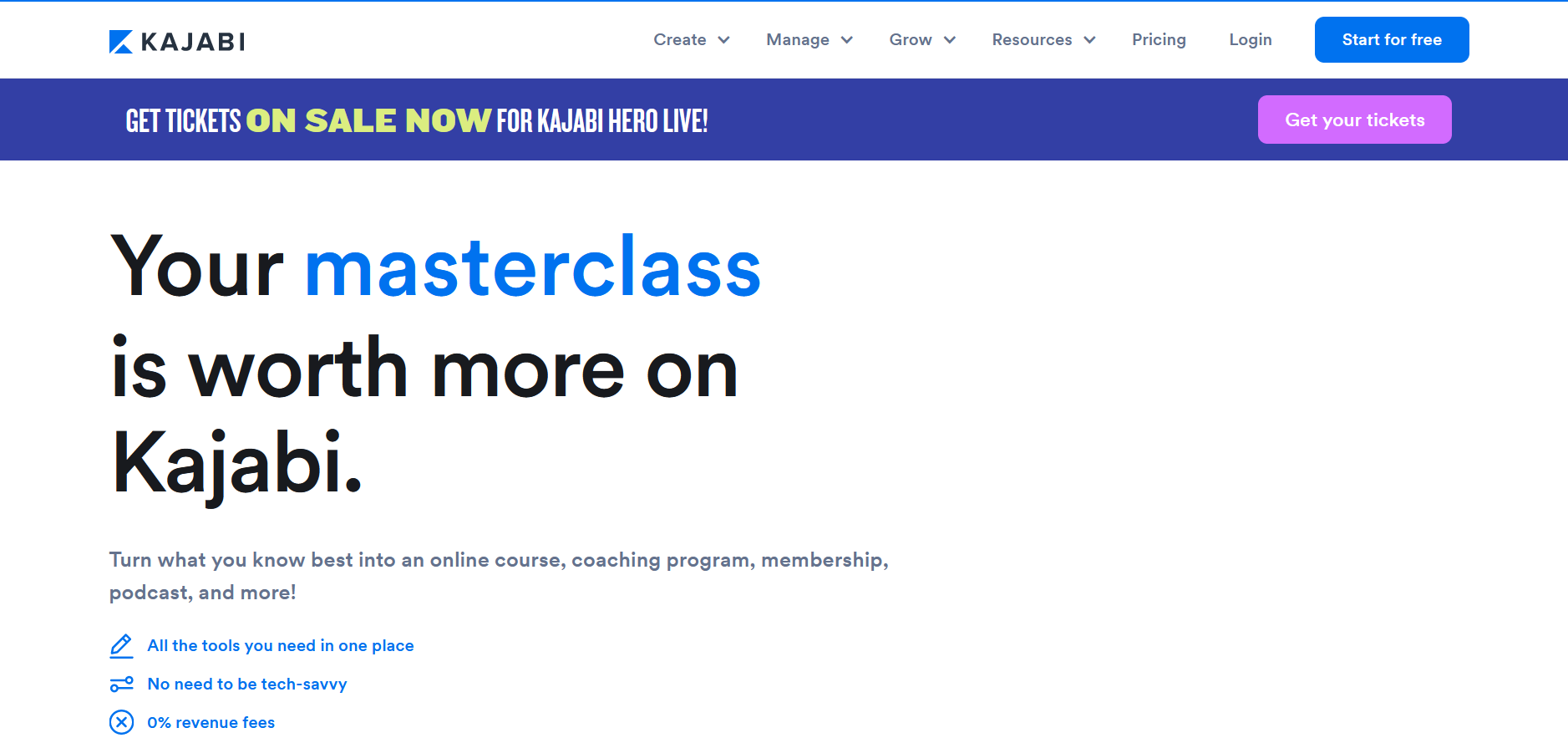
Kajabi is an online course and membership site builder that makes it easy to sell your courses and memberships online. It’s an excellent platform for anyone who wants to sell their knowledge, whether you’re an expert in your field or just getting started.
Kajabi has everything you need to create and sell your courses and memberships, including powerful tools for creating online courses, drip content, and delivering content to your students. It’s also got built-in email marketing tools and integrations with payment processors like Stripe, so you can start selling right away.
As a course creation software, Kajabi is designed to help you succeed. They’ve got a ton of helpful resources, from video tutorials to email support, so you can get the most out of the platform. Plus, their team is constantly adding new features and improvements based on feedback from users.
If you’re looking for a platform to sell your courses and memberships, Kajabi is worth checking out.
Podia:

Podia is a powerful online course platform that makes creating and selling beautiful online courses easy. With Podia, you can sell courses on your own website or embed them directly into your existing blog or website.
Podia is incredibly easy to use and comes with all the features you need to create beautiful courses. You can add video, audio, PDFs, and images to your courses, and each lesson can be as long or as short as you like. You can also offer discounts and coupons for your courses and set up a payment plan so that students can pay for your course over time.
Best of all, Podia takes care of all the technical aspects of selling your course so that you can focus on creating great content. All you need is a computer and an internet connection, and you’re ready to start selling courses on Podia!
OpenSesame
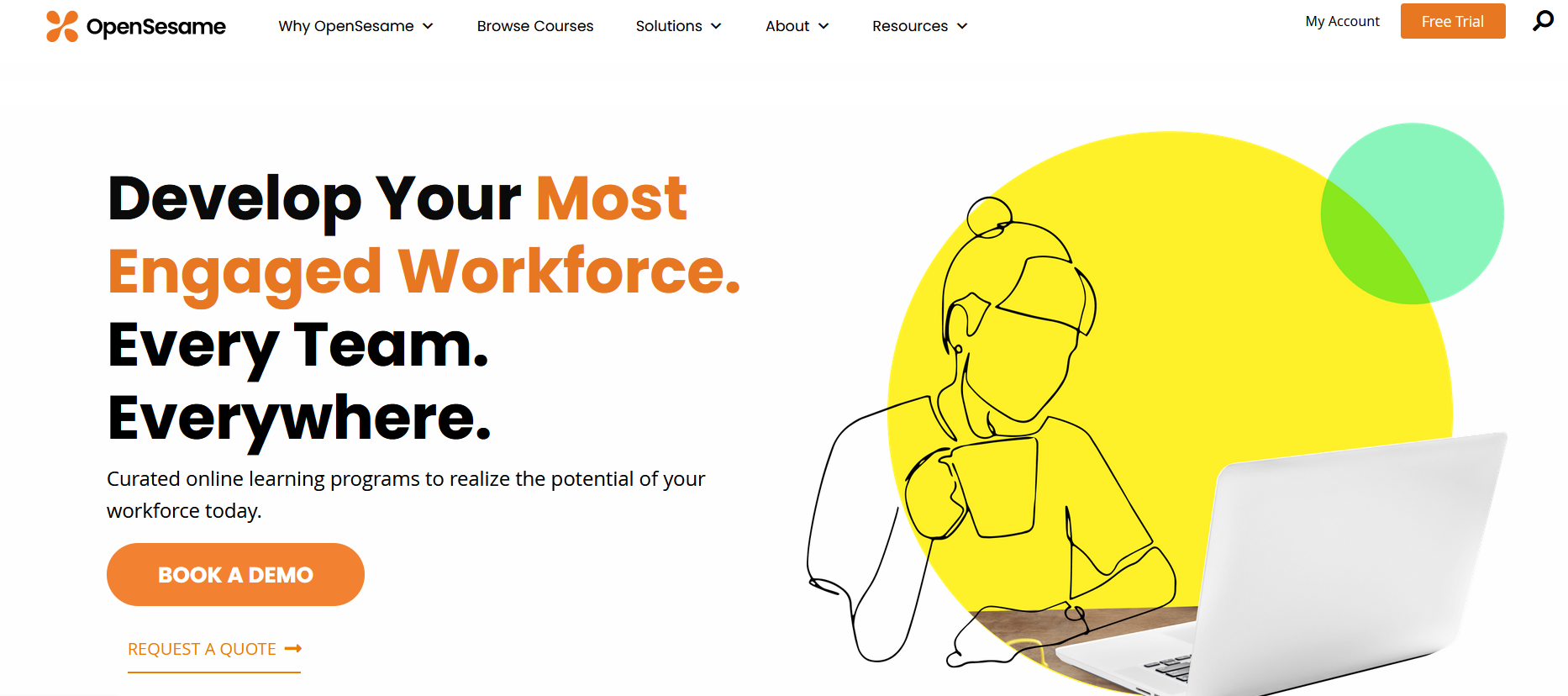
OpenSesame is an e-learning platform that helps you create, deliver, and track online training courses. It’s simple to use and great for creating engaging, interactive learning experiences. Here’s an overview of what OpenSesame can do:
With OpenSesame, you can easily create and sell online courses. The platform supports various course formats, including tutorials, self-paced learning modules, and even video-based courses. You can also add quizzes and surveys to your courses to measure learner engagement and progress.
OpenSesame makes it easy to track learner progress and activity. The platform provides detailed reports on course completion rates, time spent on each module, quiz scores, and more. With the built-in analytics tools, you can also see how learners progress over time.
OpenSesame is great for creating engaging, interactive learning experiences. With the built-in multimedia features, you can add audio, video, and images to your courses to make them more engaging. You can also create branching scenarios and add game-based elements to your courses.
WizIQ:
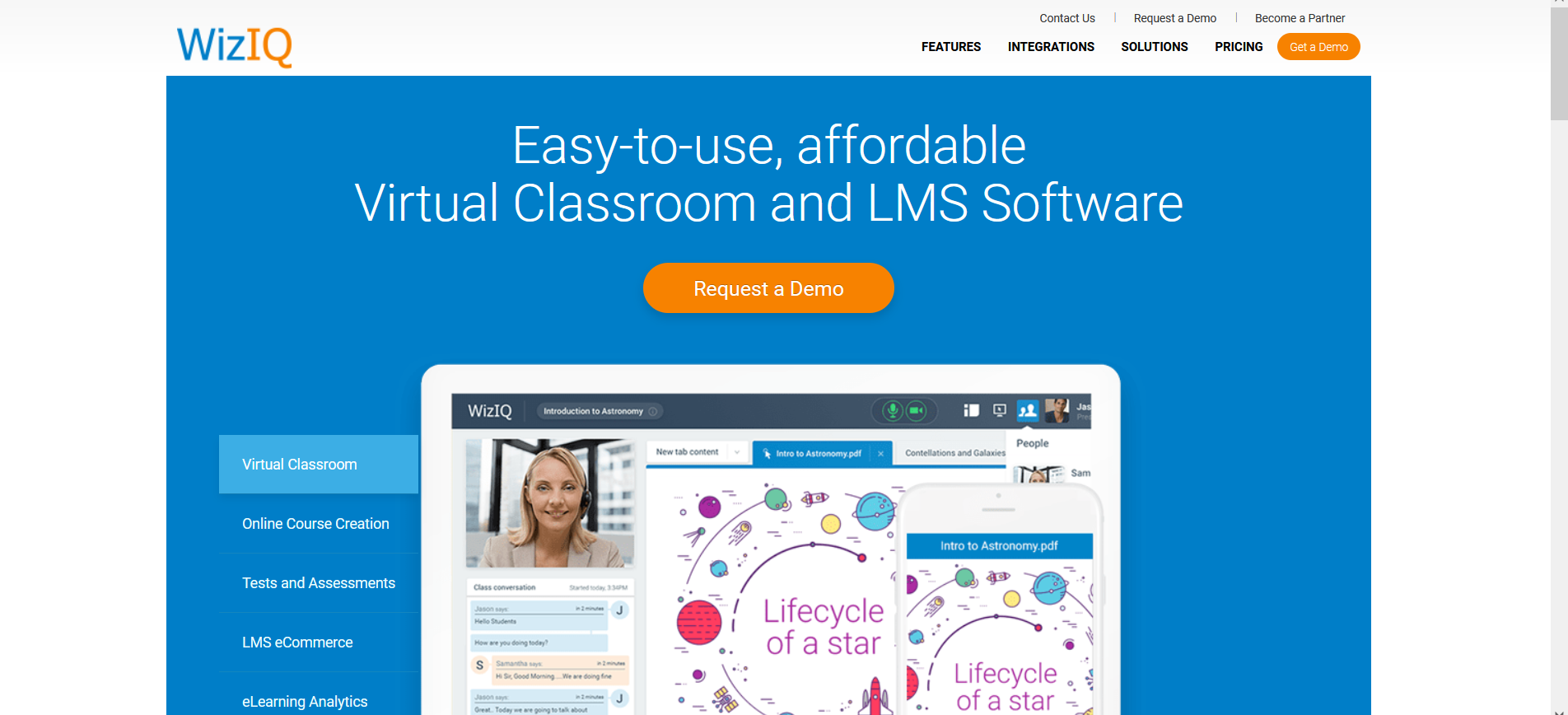
If you’re looking for a powerful and easy-to-use online teaching platform, WizIQ is definitely worth checking out.
With WizIQ, you can deliver live or self-paced courses, create engaging content with multimedia tools, and track your student’s progress. And best of all, WizIQ is great for teachers and learners – whether you’re just getting started with online learning or a seasoned pro.
So what makes WizIQ so great? Let’s start with the basics:
WizIQ is an online learning platform that helps you deliver quality instruction to your students. With WizIQ, you can create and offer live or self-paced courses using a variety of engaging multimedia tools. You can also easily track your student’s progress and performance.
In addition, WizIQ offers a wide range of features that make it an ideal choice for both teachers and learners.
For starters, WizIQ provides everything you need to get started with online teaching. The platform is easy to use and comes with all the necessary tools for creating engaging content.
Plus, there’s no need to download or install any software – everything works right in your web browser. It is ultimately the best course creation software. And if you ever need help, the friendly support team is always just a click away.
WizIQ is also great for learners. The platform offers a variety of features that make learning fun and interactive – such as quizzes, polls, forums, and chat rooms.
LearnWorlds:
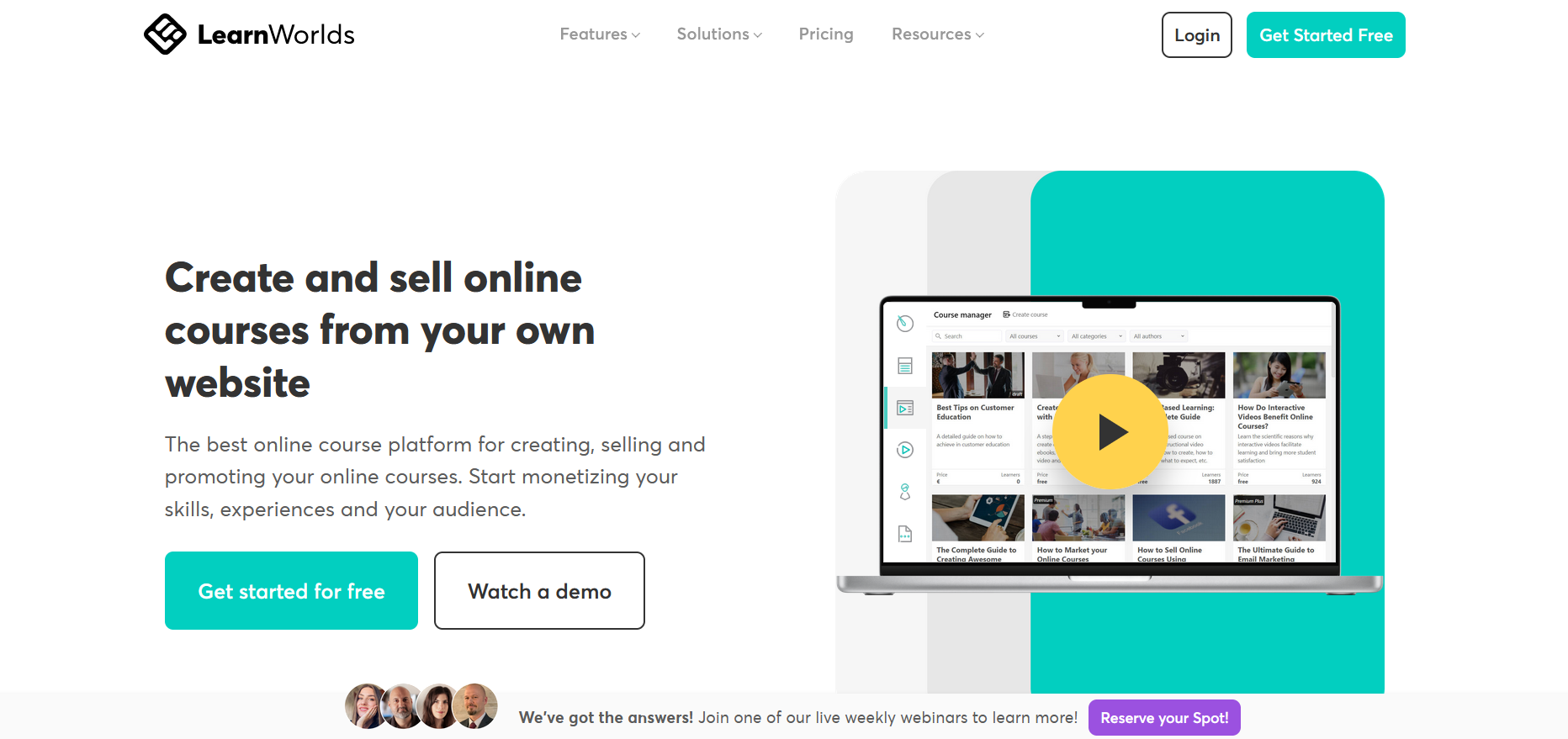
LearnWorlds is an online authoring and e-learning platform that enables users to create, deliver, and manage digital learning content. The LearnWorlds software suite offers a wide range of features and tools for creating, producing, and managing digital learning content.
These include:
-
An online editor for creating and editing digital learning content
-
A media manager for uploading and managing multimedia files
-
A course builder for creating and delivering courses
-
A quiz builder for creating and delivering quizzes
-
A reporting tool for tracking learner progress
-
An eCommerce tool for selling courses online
Its ease of use makes LearnWorlds particularly great for authoring and delivering digital learning content. The platform is highly user-friendly, with a clear and intuitive interface. This makes creating and producing engaging and interactive digital learning experiences easy.
Ruzuku:
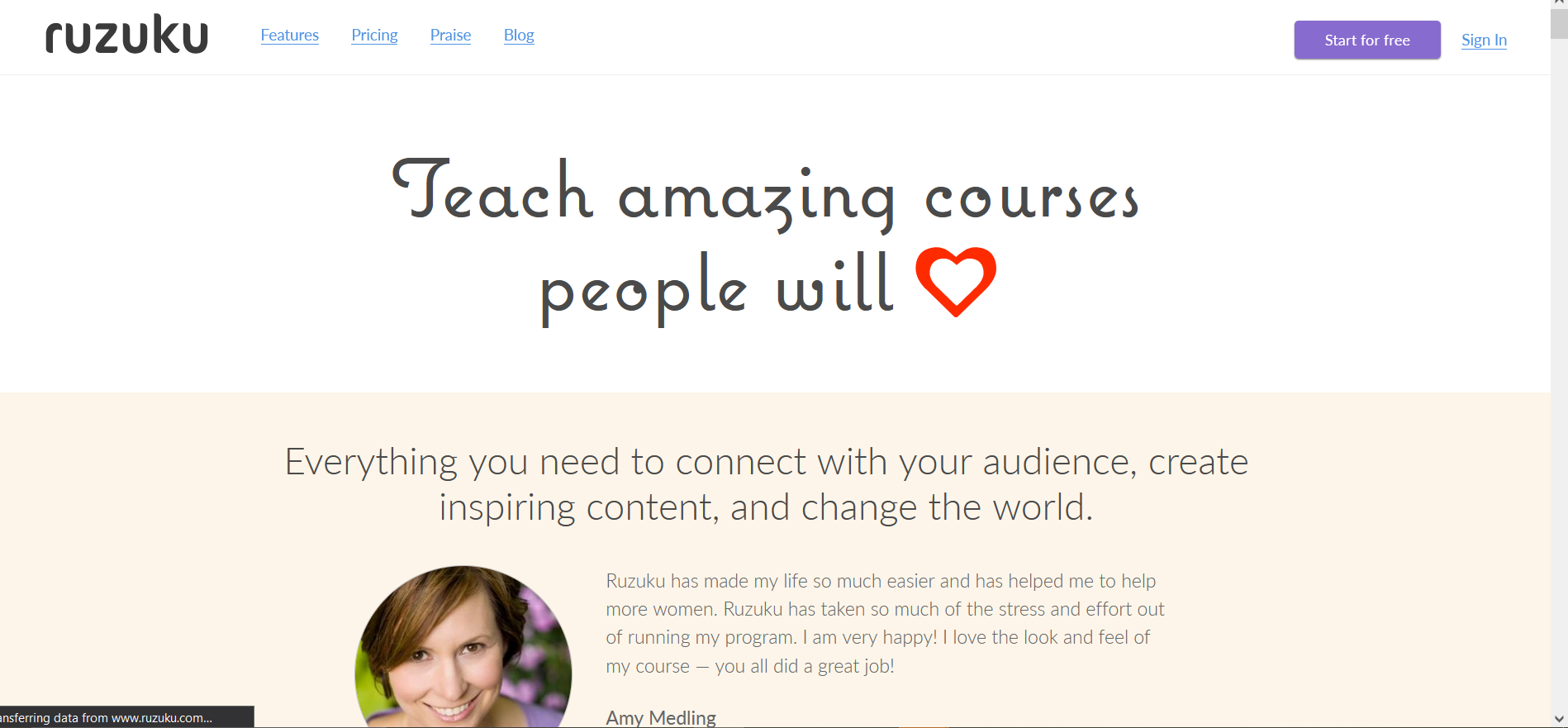
If you’re looking for a comprehensive, all-in-one e-learning platform, Ruzuku may be just what you need. With its robust feature set and intuitive design, Ruzuku makes creating and delivering engaging online courses easy.
This online course builder platform offers a variety of features that make it an excellent choice for e-learning. For starters, it’s easy to use and navigate. Creating courses is simple and straightforward, and plenty of tools and resources are available to help you along the way.
Additionally, Ruzuku is highly customizable, so you can tailor your courses to fit your specific needs. And if you’re ever stuck or need some help, the customer support team is always on hand to lend a helping hand.
So what is Ruzuku great for? Just about anything! Whether you’re looking to create an online course for yourself or for others, Ruzuku has everything you need to get started. So why not give it a try today?
TalentLMS:

TalentLMS is a cloud-based learning management system (LMS) that helps businesses train their employees, partners, and customers. It offers a wide range of features and is simple to use. You can create courses, assign training, track progress, and measure results. Plus, it integrates with your existing tools and systems.
So what exactly is TalentLMS great for? Well, it’s perfect for onboarding new hires and providing ongoing training to your team.
It’s also great for creating custom training programs or continuing education courses. In short, if you need to deliver training to anyone, TalentLMS is a good option.
LearnDash:
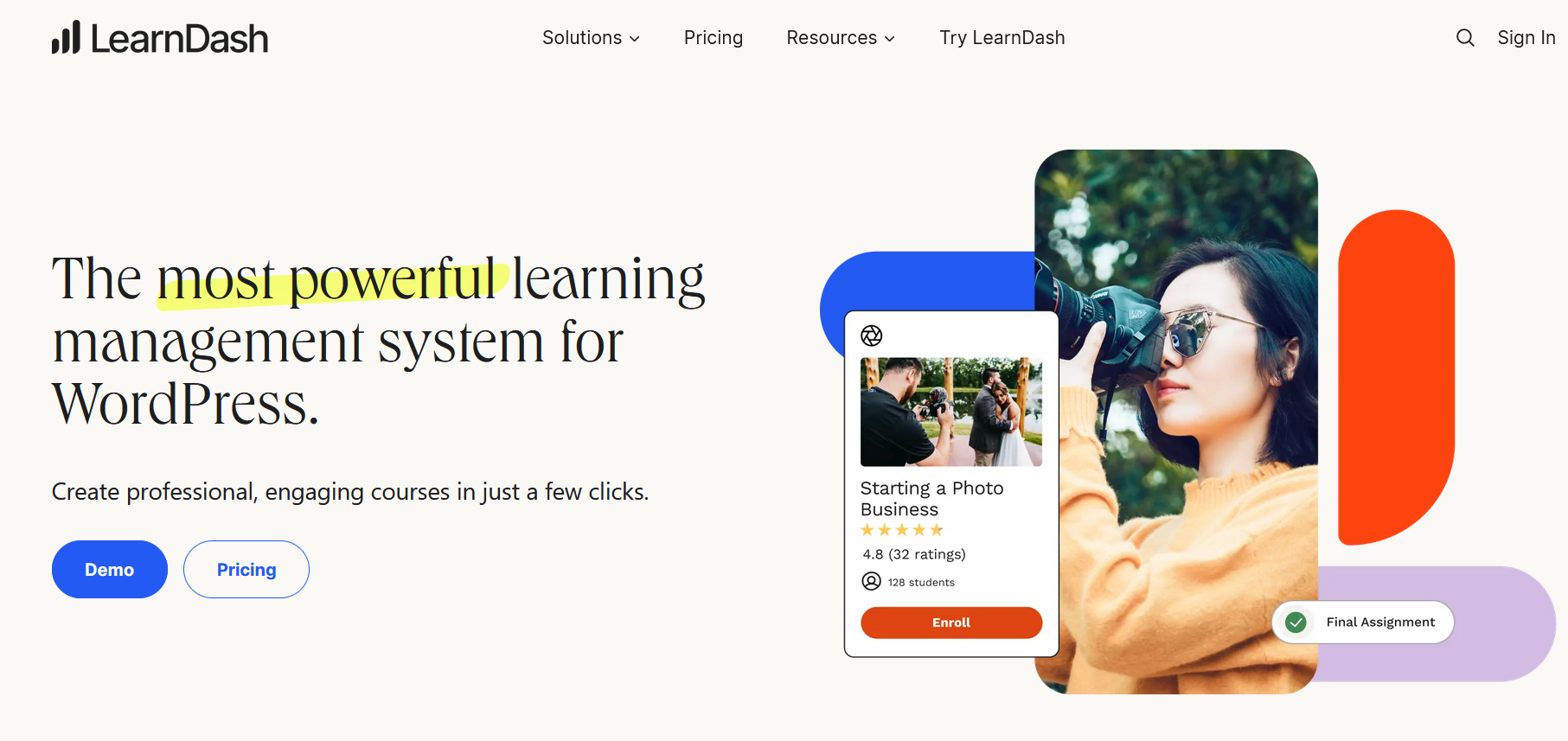
LearnDash is a WordPress plugin that makes creating, managing, and selling online courses easy. With LearnDash, you can easily create and sell courses on your WordPress site without any coding required.
LearnDash also includes powerful features for creating dynamic and interactive courses, including quiz modules, video lessons, and more. So what makes LearnDash great for creating online courses?
First off, it’s incredibly easy to use. Even if you’re not a technical person, you can easily create and manage your courses with LearnDash.
Second, LearnDash includes powerful features that make your courses more dynamic and engaging for your students. For example, with the quiz module, you can easily add quizzes to your courses to test your students’ knowledge. And with the video lesson feature, you can easily add videos to your courses to make them more engaging and visually appealing.
Finally, one of the best things about LearnDash is that it’s very affordable. Unlike other course platforms that can cost hundreds or even thousands of dollars per month, LearnDash only costs $159 per year (or $15 per month if you pay monthly).
That makes it a great option for those on a budget who still want to create high-quality online courses.
Up Grad:

If you’re a teacher, there’s a good chance you’ve heard of Up Grad. It’s one of the most popular online teaching platforms out there, and for a good reason. Up Grad is incredibly user-friendly and has tons of features that make it great for both teachers and students.
One of the best things about Up Grad is that it’s totally free to use. That means you can create as many courses as you want and host them on the platform without having to pay a dime. I mean zero transaction fees and an unlimited free plan.
There are also no limits on the number of students you can have in your courses, which is perfect if you’re teaching a large class.
Up Grad also has some great features for making your courses more interactive and engaging. You can add video lessons, quizzes, and polls to your classes to make them more interesting for your students.
And if you’re looking for more ways to connect with your students, there’s a built-in messaging system that makes it easy to communicate with them outside of class. So, there is no fear of how to handle unlimited students.
All in all, Up Grad, is an excellent choice for teachers who are looking for an easy-to-use online teaching platform. It’s free to use, has tons of great features, and is perfect for both teachers and students.
Simplilearn:

Simplilearn is a fantastic online teaching and learning platform where you can share your knowledge and build a network of teaching professionals. You can help and aid students while also advancing your own career and earning a good living.
Simplilearn’s goal is to build a platform where qualified trainers and industry experts can collaborate to create attractive, engaging, and informative content for students.
Simplilearn places a special emphasis on developing online courses in areas such as Cloud computing, Big Data, Full Stack development, and many others.
This is one of the most effective online teaching platforms to learn from.
With so many courses available, students can become confused; therefore, online course comparison can assist you in determining which course is best for you.
Being an online educator at Simplilearn will provide all the tools you need for building online courses. It will also give you access to an elite training community.
The content you create will be used to train students all over the world and advance their careers. Through its revenue-sharing model, Simplilearn promises to pay you fairly.
Like most online course platforms, it is pretty easy to begin selling online courses. Simply out an online form at Simplilearn and wait for one of their representatives to contact you.
Open Learning:

Open learning is an online course creation platform where educators with an entrepreneurial mindset can design and deliver relevant learning experiences to students.
This online learning platform allows you to create and market your online course for active learning. They believe that content is king and are looking for the best course content for the topic you are teaching.
Open learning gives you everything you need to develop your own course, design it, deliver it, and market it to students. It is basically an all-in-one platform. With the technicalities taken care of, Open Learning allows you to devote your time to creating and providing high-quality content.
The online teaching platform encourages students to learn through the use of video content, text-based content, files, and images. So, you can create a course curriculum as rich as possible with different content types.
You can register on the website and choose a plan that works for you. Plans begin at $60 per month for one educator, with a 30-day trial period included.
Course Craft:
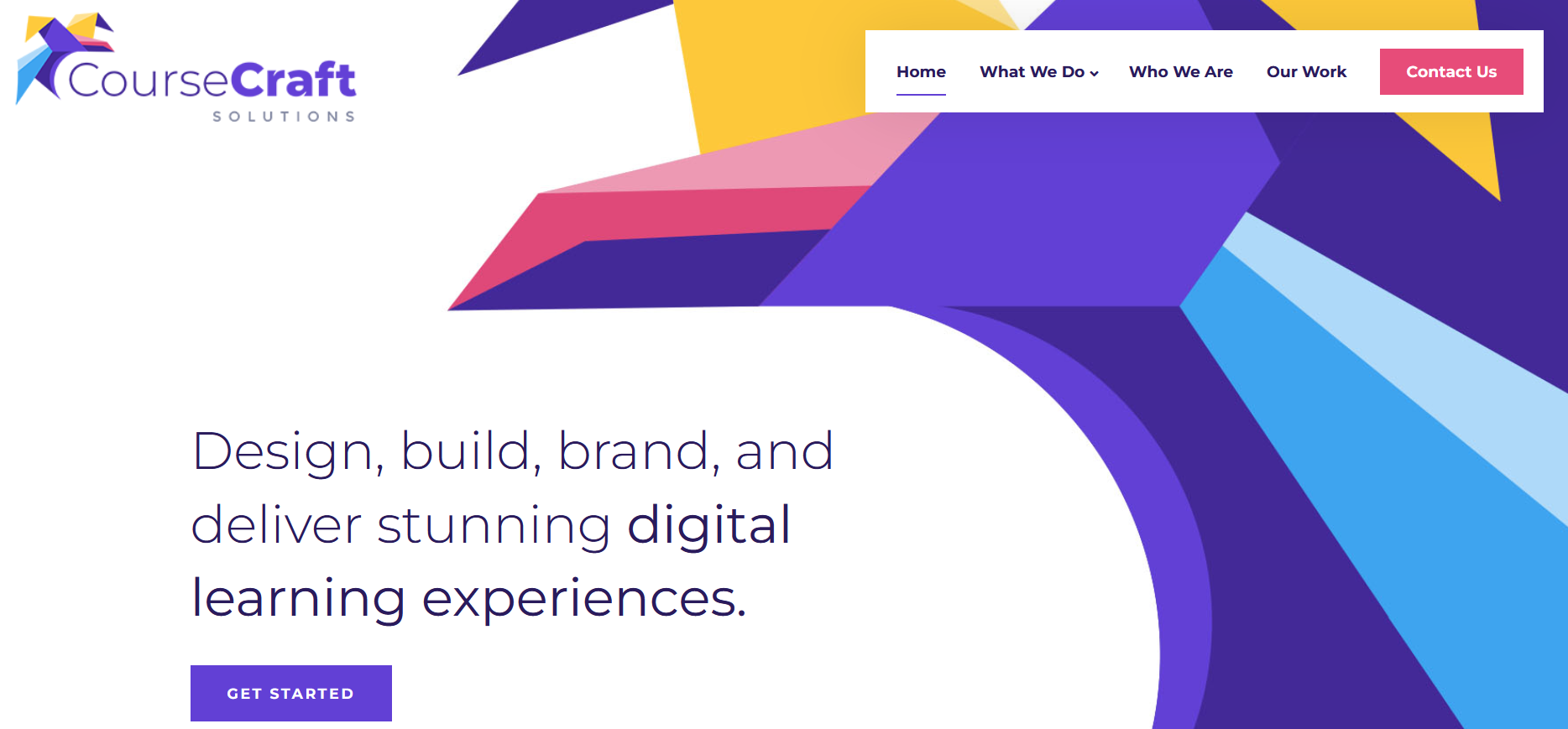
Course Craft is yet another important online course platform for educators. It is an easy-to-use online teaching platform that allows you to create any course you want.
You can offer unlimited courses, and the platform doesn’t limit the amount of content you can make for the purpose of teaching.
You can also plan and schedule your classes according to your preferences. You can also have private courses where you decide who has access to your course and the course materials. When a student enrolls in your class, you will be paid directly through PayPal.
You can begin with a free plan on Course Craft, where you will be charged 9% of your transaction fee, have limited access to the platform’s features, and can only offer three courses.
These restrictions will not apply to paid plans starting at $79 or higher.
Factors to consider when choosing an online course platform (As a Student)
Here are the following factors to consider as a student before enrolling or paying for any online course.
A. Course content and quality
As a student, there are a few key factors you should consider when choosing an online course platform.
First and foremost, you want to ensure that the course content and quality are up to par. After all, you’re paying for this education, so you want to get your money’s worth!
Look for courses that are well-organized, with clear learning objectives, and cover topics in depth to provide a complete understanding of the subject matter.
Then, you’ll want to consider the price point. Are the courses affordable? Do they offer discounts or financial aid options?
Also, take a look at your instructor’s qualifications and expertise. You don’t want to pay your hard-earned money to someone who is just winging it as they go. Verify that the course instructors are experts in their fields, with relevant experience and credentials, to ensure that you receive accurate and up-to-date information.
By taking all of these factors into consideration, you can be sure to choose the best online course platform for your needs!
B. Learning experience and user interface
The learning experience is the number one priority when choosing online learning platforms. A good learning management system will make it easy to find and enroll in courses, provide detailed information on each course, and offer a variety of features to enhance the learning experience.
So, choose a platform with a user-friendly interface that allows you to easily access course materials, track progress, and manage your learning.
The user interface should be intuitive and easy to use; it should be obvious how to navigate the site and find the information you need.
Also, look out for platforms that come with an online community, and provide supplemental resources, such as lecture notes, reading materials, or study guides, to enhance your understanding of the course content.
Opt for platforms that incorporate interactive components like quizzes, simulations, or exercises to make learning more engaging and help reinforce concepts.
C. Course format and flexibility:
Determine whether you prefer a self-paced learning experience, where you can progress through the course at your own pace, or an instructor-led format with a set schedule and deadlines. This will help you pick the right learning platform.
Also, confirm if the platform offers live sessions, webinars, or Q&A opportunities with instructors, which can provide real-time interaction and clarification of concepts.
Finally, consider platforms with mobile apps or mobile-friendly websites, enabling you to access course content and learn from any device, anywhere, and anytime.
D. Peer interaction and networking opportunities
Look for platforms that facilitate peer interaction through forums or discussion boards, allowing you to ask questions, share ideas, and learn from your fellow students.
If you learn better with group activities, look for a platform that organizes such. Some venues offer group projects or collaborative learning activities that can help you develop teamwork, communication, and problem-solving skills.
Also, put in mind that platforms that organize networking events or virtual meetups can provide opportunities to connect with fellow students or professionals in your field of interest.
E. Pricing and value for money
Evaluate the platform’s pricing structure, including course fees and available payment options, to ensure they align with your budget.
Some platforms offer discounts, scholarships, or free trials, making it more accessible and affordable for students to enroll in courses.
Platforms that grant long-term or lifetime access to course materials provide added value, as you can revisit the content for future reference or review.
F. Platform reputation and credibility
When choosing an online course platform, there are a few things you should take into account. First and foremost, you want to consider the reputation and credibility of the platform. Make sure you read reviews from other students to get a sense of whether or not the platform is reliable.
Research user reviews and ratings to get a sense of the overall learning experience and satisfaction of previous students on the platform.
Also, note that platforms that offer course completion certificates or industry-recognized certifications can add value to your resume and enhance your professional credibility.
Explore success stories and alums testimonials to gauge how the platform has impacted students’ careers, personal growth, and skill development.
By considering these factors in detail, students can make informed decisions when choosing an online course platform that aligns with their needs, preferences, and goals.
Factors to consider when choosing an online course platform (As a teacher)
A. Your target audience and their needs:
There are a lot of different factors to consider when choosing an online course platform. The most important factor, however, is your target audience and their needs.
-
What do they need from an online course platform?
-
What are their learning styles?
-
How much interaction do they need?
Once you’ve considered your audience’s needs, you can start looking at the different features of each platform.
-
Do they have the right mix of features for your audience?
-
Are the features easy to use?
-
Is the platform reliable?
Finally, you’ll need to consider your own needs as a teacher.
-
What kind of features do you need to make your life easier?
-
Which platforms offer those features?
By taking all of these factors into consideration, you should be able to choose the perfect online course platform for your needs.
B. The type of content you want to create.
When choosing an online course creation software, the type of content you want to create is just one of the factors you need to consider.
If you’re planning on creating a lot of video content, then you’ll need to make sure the platform you choose can handle large files and has good streaming capabilities. It will be best to go with a platform with unlimited video hosting.
If you’re more focused on creating text-based content, then you’ll want to make sure the platform has good editing capabilities and allows for easy collaboration.
Whatever format you decide to follow, you have to make sure that it is an interactive learning experience.
C. Your budget and revenue goals
If you’re just getting started with an online course creation, you may not have a large budget to work with. In that case, platforms like Udemy or Teachable can be a good option since they offer relatively low-cost options for creating and selling courses.
However, if you’re hoping to generate significant revenue from your courses, you’ll need to choose a platform that allows you to keep more of the revenue from course sales.
Platforms like Kajabi or Ruzuku allow you to do that by charging a monthly subscription fee instead of taking a percentage of each course sale.
Another factor to consider is the features and tools that are important to you. If you need powerful marketing tools to help promote and sell your courses, Kajabi or Ruzuku might be a good option.
If you need more flexibility in terms of pricing or course delivery, Udemy or Teachable could be a better fit.
And if you’re looking for a platform that offers both self-paced and live-paced courses, Thinkific could be worth considering.
No matter which platforms you choose, make sure it’s one that will help you meet your specific goals and needs.
D. Technical requirements and support
There are a few technical requirements and support factors you should consider when choosing the best online course platform for you.
First, can the platform accommodate different types of content?
For example, will it allow you to upload videos, write articles, or create multimedia presentations?
Second, what kind of support does the platform offer? Are there FAQs or a user forum where you can get help if you run into problems?
Third, is the platform compatible with the devices and software you use? For example, if you plan to use mobile apps or streaming services, make sure the platform can accommodate them.
Fourth, how easy is it to use the platform? Does it have a simple interface that’s easy to navigate, or is it more complex with lots of features?
Last but not least, what kind of price tag does the platform come with? Is it a free service, or does it require a subscription?
By considering these factors when choosing an online course platform, you can ensure that you select the best option to meet your needs, goals, and target audience’s expectations.
It’s essential to thoroughly research each platform’s offerings and compare them to make an informed decision.
Now that you know what to look out for, let’s examine what it entails to create and sell online courses.
How to Create and Sell A Successful Online Course
A. Planning and outlining your course content
-
Define clear learning objectives: Set specific, measurable, achievable, relevant, and time-bound (SMART) objectives that outline what students should know or be able to do after completing the course.
-
Conduct a needs assessment: Research your target audience’s needs, preferences, and potential knowledge gaps to create content that is tailored to their requirements.
-
Develop a course outline: Organize the course content into modules or sections with a logical flow that builds on previous concepts to facilitate effective learning.
B. Engaging and interactive course design.
-
Use a variety of multimedia elements: Incorporate videos, audio, images, and interactive features to cater to different learning styles and keep students engaged.
-
Break content into bite-sized pieces: Divide the content into small, manageable chunks to make it easier for students to digest and retain information.
-
Encourage active learning: Include activities, quizzes, or assignments that require students to apply the concepts they’ve learned, promoting knowledge retention and skill development.
C. Promotion and marketing strategies
-
Identify your unique selling proposition (USP): Determine what sets your course apart from competitors and emphasize these features in your marketing efforts.
-
Utilize social media and content marketing: Share valuable content, such as blog posts, articles, or infographics, on social media platforms to raise awareness about your course and showcase your expertise.
-
Collaborate with influencers or industry experts: Partner with influencers or experts in your field to promote your course, tapping into their existing audience and leveraging their credibility.
D. Providing ongoing support and community engagement
-
Offer timely and personalized feedback: Respond to students’ questions, comments, or concerns promptly, and provide customized feedback on their progress or assignments to help them improve.
-
Foster a sense of community: Create a virtual space, such as a forum or Facebook group, where students can interact, share ideas, and support each other in their learning journey.
-
Encourage and incorporate student feedback: Regularly solicit feedback from your students to identify areas for improvement and make necessary adjustments to enhance the learning experience.
By following these detailed tips, you can create courses that engage and educates your target audience, ultimately helping them achieve their learning goals and driving up the sales of your online courses.
The best equipment for creating an online course.
You don’t need the most impressive setup to create a wildly successful online course. You will, however, require some equipment. Let’s go over your main course gear options.
Microphones range in price from $30 to $99.
Even if your content is fantastic, poor audio quality detracts from the learning experience. Audio is more important than video.
Try the Samson Go Mic, a small USB microphone with excellent sound capture that costs around $30.
I have a Blue Yeti USB desk microphone. A little more expensive but excellent quality, and you get the quick podcasters/course creator vibe. It is a popular microphone for recording webinars, courses, and podcasts.
Camera / Webcam ($0 – $60)
Most laptops and computers have built-in cameras, so you may not need an additional one. However, if you require a webcam or wish to upgrade to a higher-quality model, consider the Logitech BRIO Ultra HD.
Set it up on your monitor and start recording the 4K video.
Some training may require you to demonstrate your abilities on camera or on location. Thankfully, your smartphone can come to the rescue at this point.
Software for recording screen captures ($0 – $20)
Monitor and screen capture combined with video is a popular format for online courses and blended learning.
I’m currently using Zoom.us for meetings and online live training, as well as Loom for screen and video capture.
They both have free alternatives. Make sure to download all of your videos and inform attendees if they will be recorded in order to protect their privacy.
Lighting kit (from $0 to $50)
Much can be said about lighting your video course recording. Natural light is usually the best (and cheapest) option; sit close to the window and face it for even lighting. A ring light or desk lighting kit will ensure that your training videos are well-lit, even late at night.
Maximizing the Potential of Online Course Platforms (For Students)
When it comes to online courses, it’s all about getting the most out of your platform. And as a student, that means making sure you’re using all the features and tools available to you. Here are a few tips for getting the most out of your online course platform:
I. Selecting the right online course platform and course.
When it comes to choosing an online course platform and course, there are a few things you should keep in mind.
-
Identify your personal learning goals and objectives. What are you hoping to get out of the course?
-
Compare the course content, structure, and instructor credentials. Make sure the course is comprehensive and covers all the topics you’re interested in.
-
Evaluate the platform’s user experience and learning resources.
Is the platform easy to use? Do they offer valuable learning materials? Do they have good documentation and support?
By keeping these factors in mind, you can choose the best online course platform for your needs.
II. Developing an effective learning strategy.
When it comes to learning effectively, there’s no one-size-fits-all approach.
What works for one person might not work for another.
That’s why it’s crucial to identify your personal learning preferences and tailor your study methods accordingly.
One way to ensure you’re studying effectively is to set SMART goals. Specific, Measurable, Achievable, Relevant, and Time-bound goals will help you stay focused and on track.
Another helpful strategy is to create a study schedule and allocate sufficient time for coursework. This way, you can make sure you’re making the most of your study time.
No matter what learning strategies you use, the most important thing is that you find what works best for you and stick with it. With a little trial and error, you’ll be able to develop an effective learning strategy that helps you ace those exams in no time!
III. Staying motivated and engaged throughout the course.
If you’re anything like me, you might find it challenging to stay motivated and engaged throughout an entire course. After all, there’s always something more exciting or fun to do than study!
However, there are a few things you can do to make sure you stay on track.
First, try to establish a dedicated learning environment. This could be a quiet space in your home where you can focus on your work without distractions. If you can’t find a quiet space at home, try going to the library or another public place where you can concentrate.
Second, track your progress and celebrate milestones. This will help you see how far you’ve come and give you a sense of accomplishment.
Finally, consider joining online study groups or forums for peer support and collaboration. These can be great resources for staying motivated and engaged, as well as for getting help with your studies.
IV. Utilizing platform features and resources to enhance learning
As someone who’s always looking for new and innovative ways to learn, I was really excited to explore the different platform features and resources available to me as a learner.
I loved being able to engage with interactive content and quizzes, participate in live webinars and Q&A sessions, and access supplementary materials like lecture notes and additional readings.
Each of these features enhanced my learning in different ways. The interactive content and quizzes helped me to understand the material on a deeper level, while the live webinars and Q&A sessions allowed me to get real-time feedback from experts. And having access to supplementary materials like lecture notes and additional readings meant that I could go beyond the basics and explore the topic in greater depth.
Overall, I was really impressed with platforms that have features and resources available to me as a learner. They helped me to engage with the material on a deeper level, get expert feedback, and explore the topic in greater depth.
V. Applying newly acquired knowledge and skills.
Acquiring new knowledge and skills is one thing, but applying them is another matter entirely. If you want to really reinforce your learning, it’s important to complete assignments and projects that put your new skills to the test.
Alternatively, you can try incorporating them into personal or professional projects to see how they work in real-world scenarios.
Either way, it’s always helpful to share your accomplishments and learnings with peers, mentors, or other professionals in your network – doing so can give you valuable feedback and help you improve even further.
VI. Seeking feedback and support.
Asking for feedback can be scary, but it’s essential for growth. The first step is to muster up the courage actually to request it from your instructor or peers. It shows that you’re trying to improve and are willing to listen to constructive criticism. Once you have the feedback, take time to process and reflect on it before making any changes.
If you’re feeling stuck, there are plenty of platform support resources available, such as tutorials or help forums. Utilizing these can help ease any frustration and get you back on track.
Additionally, connecting with fellow students for study tips and encouragement is a great way to stay motivated.
We all have different learning styles, and what works for one person might not work for another, so it’s helpful to hear various perspectives.
VII. Networking and building relationships with fellow learners
There’s no question that networking and building relationships with fellow learners can be beneficial. After all, it’s always helpful to have a supportive community of peers to rely on when you’re trying to master a new skill or concept.
Luckily, there are plenty of ways to go about networking and building relationships with your classmates, whether it’s participating in the course forums and discussion boards, attending virtual networking events, or collaborating on group projects.
Of course, some people might be naturally more inclined towards networking than others. If you’re the type of person who loves meeting new people and striking up conversations, then you’ll probably find it pretty easy to network with your fellow learners.
However, even if you’re not the most outgoing person in the world, there’s no need to worry – there are still plenty of ways for you to build relationships with your classmates. For example, why not start by participating in some of the course forums and discussion boards?
You don’t necessarily have to be the one leading the conversation – simply chiming in every now and then can help you get started.
Once you’ve gotten comfortable interacting with your peers online, you could also try attending some virtual networking events or meetups. These can be great opportunities to meet new people and learn more about what others are doing in their courses.
And finally, collaborating on group projects is another great way to build relationships with your classmates while also getting some valuable work experience under your belt.
VIII. Enhancing your digital learning skills
As online learning becomes increasingly common, it’s essential to develop skills that will help you succeed in this type of environment.
Familiarizing yourself with standard online learning tools and software, developing effective online communication and collaboration skills, and staying up-to-date with emerging trends and technologies in online education are all critical factors in digital learning success.
One way to familiarize yourself with online learning tools and software is to take some time to explore different platforms and become familiar with their features. Many platforms offer tutorials or support forums where you can learn more about how to use specific features. Additionally, there are a number of great resources available online (such as blog articles, YouTube videos, etc.) that can help you learn more about using various digital tools for learning.
Developing effective online communication and collaboration skills is another key element of successful digital learning. Since you’ll be communicating and collaborating with others via the Internet, it’s essential to make sure you’re doing so in a way that is clear, concise, and respectful.
There are a few easy ways to do this:
-
Make sure you’re using proper grammar and spelling.
-
Be mindful of the tone of your messages (i.e., avoid sounding too harsh or critical);
-
Try to be as clear as possible when sharing ideas or giving directions.
-
Give people ample time to respond to messages or requests.
-
Be patient when waiting for responses.
-
Use appropriate emoji/icons when appropriate.
IX. Evaluating course outcomes and success.
It’s always a good idea to reflect on what you hoped to get out of a course before you dive in and then again once you’ve completed it.
This helps you to measure your own personal growth, skill development, or career advancement against your expectations.
It can also be helpful to provide feedback to instructors and the online platform itself to help make future offerings even better.
Identify areas where you need improvement and congratulate you on your successes. Seeing how far you’ve come can be highly motivating, especially when it comes to learning new skills or advancing your career.
By following these guidelines, students can maximize the potential of online course platforms, ensuring they make the most of their learning experience and achieve their desired outcomes.
Maximizing the Potential of Online Course Platforms (For Teachers)
In this digital age, the best online course platforms have become a game-changer for teachers seeking to reach out to students in remote locations. The potential that these platforms offer is limitless as they can provide both the teacher and student flexibility without compromising on quality education.
But how effective are these tools? And, more importantly, how can you make the most of them? In this segment, we’ll explore tips and tricks for maximizing your use of online course platforms to ensure that each lesson hits its mark and delivers results!
I. Incorporating different learning styles into your online course.
Different students have different learning styles. Some learn best by seeing and hearing information (visual and auditory learners), while others prefer to read and write (reading/writing learners). Still, others learn best through hands-on experience (kinesthetic learners).
As an online instructor, it’s essential to be aware of these different learning styles and design your course content accordingly.
Visual learners will benefit from videos, infographics, and other visual aids. Auditory learners will do well with podcasts, webinars, and other audio resources. Reading/writing learners will appreciate well-written articles, eBooks, and other text-based materials. And kinesthetic learners will benefit from interactive exercises, simulations, and other hands-on activities.
Of course, you can’t create separate pieces of content for every single learning style. That would be too time-consuming! Instead, try to balance various learning styles throughout your course. This will give all students a chance to learn in a way that works best for them.
II. Creating an inclusive and accessible online course.
In today’s world, it’s more important than ever to make sure that your online course is accessible to everyone. That means ensuring that your content is accessible to people with disabilities, designing for different device types and screen sizes, and providing language support and translation options.
Making sure your content is accessible to people with disabilities is vital. You can do this by captioning videos and providing transcripts, making sure your site is compatible with screen readers, and ensuring keyboard navigation works properly.
Designing for different device types and screen sizes is also important. People use all sorts of devices to access the Internet these days, so you need to make sure your site looks good on everything from a desktop computer to a smartphone. And don’t forget about tablets!
Finally, language support and translation options are critical if you want to reach a global audience. Make sure your site can be displayed in multiple languages and offer translations for any text content. By taking these steps, you’ll ensure that everyone can enjoy your online course!
III. Tracking student progress and success
There’s no question that data tracking and analysis are becoming increasingly important in all facets of life. And when it comes to student success, the best online course platforms are under pressure to make sure their students are progressing and meeting standards. That’s where learning analytics comes in.
Learning analytics is the process of collecting data about student performance and using that data to identify trends and patterns. This information can then be used to adapt course content, improve teaching methods, and support students who may be struggling.
Data tracking can help identify key performance indicators (KPIs) for student success. By understanding which factors are most closely linked to success, educators can focus on what’s most important. For example, if attendance is a strong predictor of success, then interventions can be put in place to support students who have excessive absences.
Ultimately, data tracking and analysis are powerful tools that can be used to support student success. By understanding how students are performing, educators can make necessary adjustments to ensure that all students have the opportunity to succeed.
IV. Leveraging gamification to enhance the learning experience.
Gamification is the use of game elements and mechanics in non-game contexts to engage and motivate people. When leveraged correctly, it can be a powerful tool to enhance the learning experience.
The basics of gamification involve incorporating elements of fun and competition into an online course to encourage students to stay engaged. This can be done in several ways, such as awarding points for completing tasks, providing badges for achievements, and creating leaderboards to add a sense of social interaction and competition.
When incorporating gamification into your online course, it’s essential to strike the right balance between too much and too little. Too much gamification can quickly become overwhelming and distracting, while too little can fail to capture students’ attention. Ultimately, the goal is to make learning more enjoyable and engaging without sacrificing the quality of the content.
There are a number of ways to assess the impact of gamification on student engagement. One standard method is surveying students at the end of the course to gauge their satisfaction levels. Another approach is to track student progress over time to see if there is a correlation between increased engagement and improved performance.
Gamification can be a great way to breathe new life into an online course. By understanding the basics and incorporating elements strategically, you can create an engaging learning experience that motivates and inspires students.
V. Building and maintaining an online course community.
Building and maintaining an online course community can be a bit of a challenge. You have to constantly think about how to keep people engaged and motivated while also providing support and guidance. But it’s worth it because having a strong community can make all the difference in whether or not your course is successful.
Here are some tips for creating and maintaining an online course community:
-
Establish guidelines and expectations for community interactions:
It’s essential to set the tone for how you want people to interact with each other in your community. Will it be formal or informal? Serious or light-hearted? Respectful or rowdy? By establishing guidelines early on, you’ll help ensure that everyone is on the same page and that everyone enjoys participating in the community. -
Encourage collaboration and peer support:
One of the best things about online courses is that they provide an opportunity for people to learn from each other. Encourage your community members to collaborate with each other and offer support when needed. This will help create a more supportive and friendly environment. -
Facilitate networking opportunities and relationship-building:
Networking is one of the most important aspects of online learning. It allows people to connect with each other, share resources, and build relationships. Make sure to facilitate networking opportunities within your community so that people can get the most out of their experience.
VI. Continuous improvement and course updates
It is not enough to just create online courses; you have to keep improving and updating the courses continuously. This way, students are kept engaged, and you keep selling online courses.
A regular review of course content helps to identify areas that need updating while also providing an opportunity to assess whether the overall structure of the course is still effective.
It’s also essential to stay abreast of changing industry trends and advancements, as this can have a direct impact on the material covered in a course. By being proactive and making adjustments as necessary, we can ensure that our courses remain relevant and valuable to students.
Finally, student feedback is an integral part of the continuous improvement process. Seeking out feedback allows us to get a sense of how students are engaging with the material, what they’re finding helpful or challenging, and what changes they would like to see.
Incorporating feedback helps to create a more dynamic and responsive learning experience for everyone involved.
VII. Diversifying revenue streams through online courses
As a business owner, it’s always a good idea to diversify your revenue streams. This way, if one area of your business slows down, you have other areas to fall back on. When it comes to online courses, there are a few different ways you can diversify your revenue streams.
One option is to offer tiered pricing or membership levels. This could mean offering a basic level of access to your course for a lower price and then increasing the cost for additional features or services. Another option is to provide other resources or services alongside your course, such as coaching or consulting. This could be an upsell for people who want more support or guidance.
You could also explore affiliate marketing or strategic partnerships. These could be win-win situations where both parties benefit from the relationship. For example, you could partner with another online course provider and cross-promote each other’s courses. Or you might team up with a complementary business to offer bundled products or services.
There are many different ways to diversify your revenue streams than just selling online courses.
So if you’re looking for ways to increase your income, why not give some of these ideas a try?
VIII. Ensuring the security and privacy of your online course.
The best online course platforms ensure the security and privacy of students’ data.
As a teacher, there are a few key things you can do to protect your students’ information:
-
Understand data protection regulations and best practices. This includes understanding how to collect, store, and use student data in a way that complies with privacy laws.
-
Implement secure payment processing and user authentication. This means using a secure payment gateway for any course fees and ensuring that only authorized users can access course content.
-
Protect course content from unauthorized access and distribution. This includes ensuring that only students who have paid for the course can access it and that unauthorized copying or distribution of the content is prevented.
By taking these steps, you can help ensure that your online course is secure and private for your students.
IX. Optimizing the onboarding experience for new students.
The onboarding experience for new students can be optimized in a few ways.
Designing an intuitive course registration process is one way to do this.
Another way is to provide a comprehensive orientation or welcome module. This can help new students get acclimated to their new surroundings and understand what is expected of them.
Finally, offering ongoing support and resources for new students can help them succeed in their studies.
By providing these things, you can make the onboarding experience smoother for new students.
X. Evaluating the long-term success of your online course.
It’s essential to evaluate the long-term success of your online course in order to ensure that it has the desired impact on students.
There are a few key ways to measure this: course completion rates, student satisfaction, and the impact of the course on students’ careers or personal growth.
By taking a close look at these factors, you can identify areas for improvement and expansion in your online education business.
Course completion rates give you a good indication of how well students are engaging with the material. If you see a high drop-off rate, it could be an indication that the content is too difficult or that students are losing interest.
Student satisfaction surveys can give you insights into what parts of the course are working well and which could use some improvement.
Finally, assessing the impact of your course on students’ careers or personal growth can help you gauge its overall success. If you see that your course is making a positive difference in people’s lives, then you know you’re doing something right!
The Future of Online Course Platforms and Their Impact on Education
The future of online course platforms is looking bright – and their impact on education is set to be huge.
The best online course platforms provide a wealth of resources and support for teachers and students alike, and they’re only getting better.
With more and more courses being offered online, it’s clear that these platforms are the way of the future.
Here’s what you need to know about the future of online course platforms and their impact on education.
Online Course Platforms are Expanding access to education
First, it’s important to understand just how popular online courses have become.
In recent years, there has been a massive uptick in the number of people taking courses online. This trend is only set to continue as online courses offer tremendous flexibility and convenience. With an online course platform, you can study at your own pace from anywhere in the world. And with the vast array of courses available, there’s something for everyone.
But it’s not just students who benefit from online course platforms – teachers are too. These platforms make it easier than ever for teachers to create and sell courses. They also provide valuable tools and resources to help teachers engage with their students and improve learning outcomes. In short, online course platforms are making a significant impact on education – both for teachers and students.
Looking ahead, it’s clear that online course platforms are here to stay. And as they continue to evolve, they will only become more ubiquitous and influential within the world of education. So if you’re not already
Online course platforms and the rise of alternative credentials
As the world of work rapidly evolves, so too do the credentials employers value. In response to this changing landscape, many online course platforms are now offering alternative credentials, such as digital badges and micro-credentials.
While traditional degrees and certificates are valuable, employers are increasingly interested in hiring candidates with demonstrated skills and knowledge in specific areas. This is where alternative credentials can play a valuable role. By validating the skills and knowledge acquired through online courses, these credentials can help job seekers stand out from the crowd.
However, it’s important to remember that not all alternative credentials are created equal. While some are well-recognized by employers, others may not be given much weight in the job market. When assessing the value of an alternative credential, it’s essential to consider its content and the reputation of the issuing institution.
Integration of virtual reality (VR) and augmented reality (AR) in online courses
Virtual reality (VR) and augmented reality (AR) are two cutting-edge technologies that are beginning to find their way into online courses. VR provides a fully immersive experience that can transport users to different environments. At the same time, AR enhances existing reality with digital information and objects. VR and AR have great potential for creating engaging and interactive learning experiences.
There are several potential applications for VR and AR in online education. For example, VR could be used to create simulations of real-world environments, such as historical settings or scientific experiments. AR could augment online resources with additional information or 3D visualizations. These technologies could also create more immersive and interactive learning experiences.
However, some challenges are associated with implementing VR and AR technologies in online courses. Firstly, these technologies require specialized hardware, which may not be widely available. Secondly, developing quality VR and AR content can be time-consuming and expensive. Finally, it can be challenging to ensure that users have a good quality VR or AR experience if they are using different types of devices or software.
Despite these challenges, VR and AR promise to enhance online education. By creating immersive and interactional learning experiences, these technologies have the potential to engage students in new and exciting ways.
The evolving role of instructors and facilitators in online education
It’s no secret that the world of education is changing rapidly. With new technologies and approaches always emerging, educators must constantly adapt to stay current and relevant. This is particularly true in the realm of online education, where the landscape is continuously evolving.
As online education becomes more prevalent, the role of instructors and facilitators must also evolve. Gone are the days when simply delivering content via a static lecture format was enough. Now, educators must be more nimble and adaptable, capable of using a variety of tools and strategies to engage students in meaningful ways.
Of course, adapting to a new environment can be challenging. That’s why it’s so essential for instructors to stay current with what’s going on in the field. There are many means available to help with this, including online professional development courses, educational blogs, and social media groups.
By staying current and adapting their teaching styles and strategies accordingly, instructors can ensure that they’re providing their students with the best possible learning experience. In an ever-changing landscape, that’s essential.
By exploring these additional aspects of online course platforms and their impact on education, you can gain a deeper understanding of the current trends and future potential of digital learning, enabling you to navigate better and capitalize on the opportunities offered by this rapidly evolving field.
Frequently Asked Questions
What are online course platforms?
An online course platform is a website that enables instructors to create and deliver courses over the Internet. Most platforms provide course management features such as assignment grading and discussion boards, while some also offer video conferencing and other tools.
Many of them also offer some form of certification or accreditation for completing the course.
There are many different online course platforms available, each with its set of distinct features and benefits. Some of the most popular platforms include Coursera, Udemy, and edX.
Instructors who want to use an online course platform to deliver their courses will need to choose one that best meets their needs. Some factors to consider include the cost of the platform, the features it offers, and whether it is compatible with the instructor’s existing content.
Which is the best online platform for learning?
There’s no shortage of online platforms that offer educational content these days. Each online platform has its own strengths and weaknesses. Some platforms are better for interactive courses, while others are better for providing content alone. You’ll need to decide which platform best suits your learning style and needs. Some popular platforms include Udemy, Coursera, edX, Codecademy, and Khan Academy.
But which one is the best for learning? That depends on a few factors, including what you’re trying to learn and how you learn best.
For example, if you’re interested in learning programming, Codecademy might be a good option. It offers interactive exercises and projects to help you build your skills.
If you’re looking for more traditional educational content, such as lectures and readings, edX might be a better fit. It offers courses from top universities and institutions around the world.
Ultimately, the best online platform for learning depends on your individual needs and preferences. So, take some time to discover your options before making a decision.
Which platform is best for online courses and is free?
There’s no one-size-fits-all answer to this – it all depends on your specific needs and preferences. That said, we can break it down into a few key factors to help you make your decision.
Do you want a platform that specializes in online educational courses? If so, Udemy and Skillshare are both excellent choices. They offer a wide range of courses on everything from business to cooking, and they’re constantly adding new options.
Prices vary depending on the course, but there are often discounts available.
If you’re looking for a more general platform with a variety of content, TED Talks or Khan Academy might be a better fit. These sites offer free educational videos on a wide range of topics, so you can learn about anything that interests you. And since they’re free, you can watch as much or as little as you like without breaking the bank.
So, which platform is best for online courses and free? Again, it all depends on your needs and preferences. But hopefully, this breakdown will help you narrow down your options and find the perfect fit for you.
What is the cheapest online course platform?
There are a lot of different online course platforms out there, and it can be tough to choose which one is right for you. If you’re looking for the cheapest option, you’ll want to check out platforms like Coursera and Udemy.
Both of these platforms offer a wide variety of courses, and they’re typically much cheaper than alternatives like edX or Skillshare.
Of course, price isn’t everything – you’ll also want to make sure that the platform you choose has the courses you’re interested in and that it’s easy to use. But if cost is your main concern, Coursera and Udemy are definitely worth checking out.
How do I choose the best online course platform for my needs?
There are many different online course platforms out there, and it can be tough to decide which one is right for you. Here are a few things to consider when choosing an online course platform:
First, think about what your needs are. Do you need a platform that is flexible and allows you to design your own courses, or do you prefer something that is more structured? There are rewards and disadvantages to both approaches.
Second, consider the cost of the platform. Some platforms are free to use, while others charge monthly or annual fees. Again, there are positives and negatives to both choices. Free platforms may have fewer features or be less reliable, while paid platforms may be more expensive but offer more features and support.
Third, take a look at the platform’s features and see if they meet your needs. Does the platform have everything you need in terms of course design, delivery, and assessment? Make sure to read reviews from other users to get a sense of what they like and don’t like about the platform.
Fourth, think about the user experience. Is the platform easy to use? Will it be intuitive for your students? Make sure to try out the platform yourself before making a decision.
Finally, trust your gut! If a platform feels right for you, then it probably is. Go with your instinct and choose the option that you feel most comfortable with.
Are online course platforms suitable for individuals and businesses?
The jury is still out about if online course platforms are suitable for everyone.
Some people swear by them, while others find them to be a frustrating waste of time.
Is it suitable for businesses? Perhaps the answer lies in who is creating the courses.
Are they well-versed in instructional design principles? Do they understand how to engage learners online?
If so, then online courses can be highly beneficial to both individuals and businesses. But if not, then it might be best to steer clear.
But here’s my take: online courses can be great for both individuals and businesses. If you’re looking to learn new skills or improve your existing ones, plenty of courses can help you do just that. And if you’re a business owner, online courses can be a great way to train your employees without having to send them off-site (not to mention they can be a lot more affordable than traditional training programs).
So what’s the bottom line? Whether you’re an individual or a business, online courses can be a great option – it just depends on what you’re looking for. So why not give them a try?
Can I create a course on multiple online course platforms?
Yes! In fact, many instructors choose to do just that. There are a few reasons why you might want to consider this approach.
First, you can reach a wider audience by creating your course on multiple platforms. Each platform has its unique user base, so you can tap into different markets by being present on various sites.
Second, some students prefer one platform over another. Offering your course on multiple platforms allows you to cater to students with their preferred learning environment.
Finally, having your course on multiple platforms can diversify your income stream.
If one platform experiences a downturn or faces other challenges, you’ll still have other sources of revenue from your other courses.
So, if you’re considering creating a course, don’t limit yourself to just one online course platform. Consider using multiple sites to reach the widest audience and generate the most income possible.
How do I market and promote my online course?
There’s no shortage of ways to market and promote your online course. The most important thing is to start with a plan and be consistent with your marketing efforts.
First, identify your target audience and where they hang out online. This will help you determine which platforms and channels will most likely reach them. Then, create content that is interesting and relevant to your audience. This could include blog posts, infographics, videos, helpful tips, or resources.
Once you have some good content, start promoting it through social media, email marketing, paid ads, or whatever channels you think will work best. The key is to be consistent and think about how to reach more people with your message.
What types of content can I include in my online course?
There’s no shortage of things you can include in your online course. The sky’s the limit, really. But to give you a starting point, here are a few ideas:
-
Lectures or talks: These can be either pre-recorded or live. If you go the live route, you can use a service like Skype or Zoom.
-
Tutorials: Show your students how to do something step-by-step. This could be anything from cooking a meal to using the software.
-
Interviews: Share interviews with experts in your field. This is a great way to add different perspectives to your course.
-
Group discussions: Get your students talking to each other! This can be done through forums, chat rooms, or video conferencing.
-
Assignments and quizzes: Keep your students engaged with assignments and quizzes throughout the course. This will help them retain what they’re learning.
You can include video content in your course. This can be helpful because it allows students to see and hear you as you explain concepts. Additionally, videos can be paused and rewatched if students need extra time to understand something.
Another option is to use audio files in your course. Audio can be a good choice if you want to provide students with extra resources to listen to at their own pace. Additionally, audio files can be used with other content types, such as slideshows or text-based materials.
Finally, you may also consider using text-based materials in your course. This can be helpful because it allows students to read through concepts at their own pace. Additionally, text-based materials can be supplemented with other content types, such as audio files or videos.
How much does it cost to use an online course platform?
The cost of an online course platform can vary depending on many factors. For example, the price may differ depending on whether you’re using a free or paid service, and the features offered by each platform can also impact the cost.
Generally speaking; however, you can expect to pay anywhere from $10 to $100 per month for access to an online course platform. Of course, this is just a rough estimate – some platforms may be more expensive or less expensive than this. Ultimately, it’s essential to shop around and compare prices before deciding.
In Conclusion
Online course platforms are becoming increasingly popular, and there are now more options than ever. With 32 of the best online course platforms to choose from in 2023, you’re sure to find one that suits your needs perfectly.
Whether you’re looking for interactive courses or just a streaming platform to host your lectures, there is an online course platform for every type of learner.
By carefully selecting the best online course platform and course, creating an effective learning strategy, staying motivated, utilizing platform resources, and actively participating in networking and community-building, you can maximize the potential of online course platforms.
The key to success lies in continuously evaluating personal learning objectives and adapting one’s online learning approach to ensure the experience remains engaging, relevant, and rewarding.
Hopefully, this list has helped narrow down your search so that you can find the perfect platform for your educational goals! Good luck!











